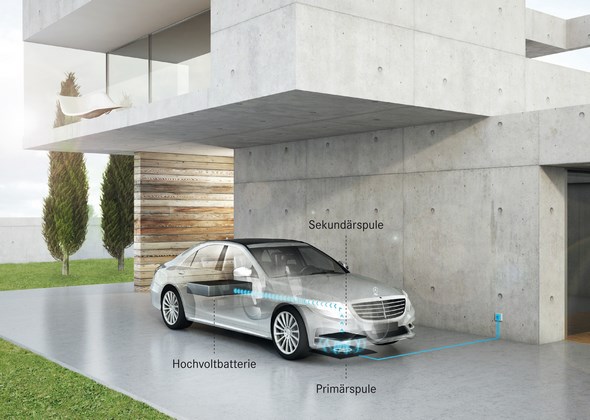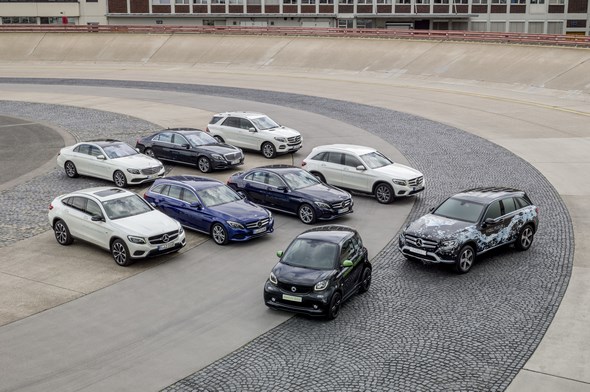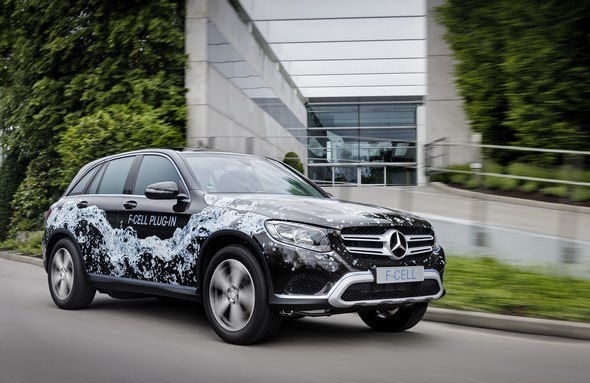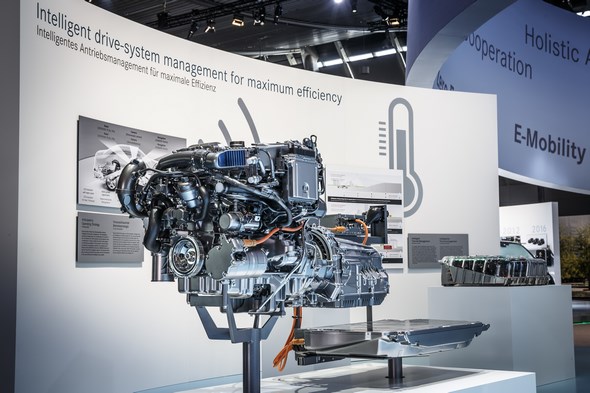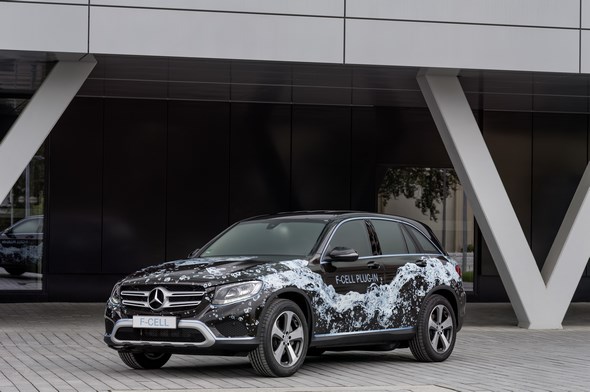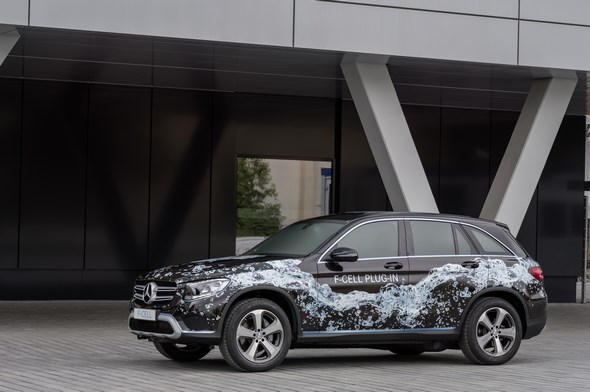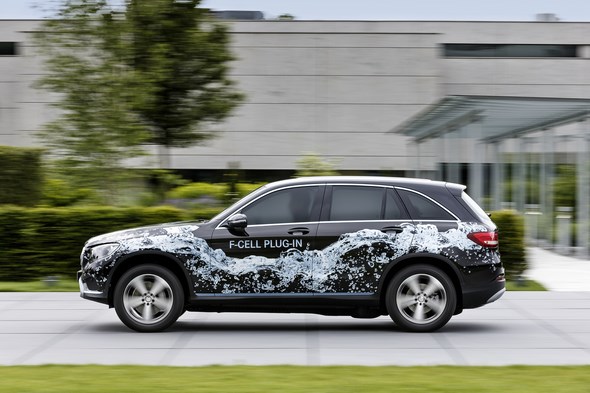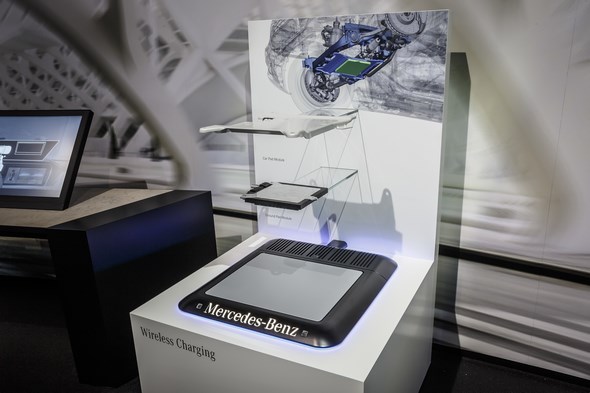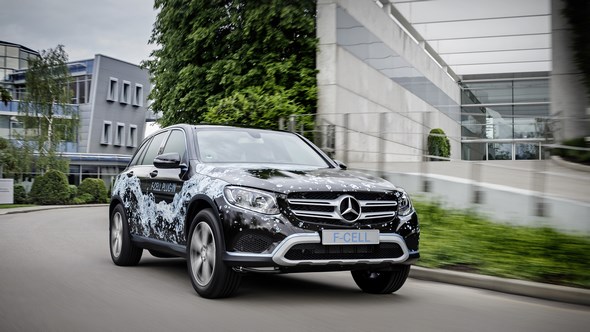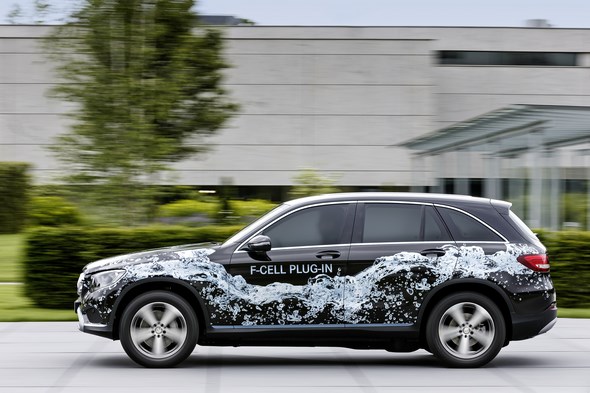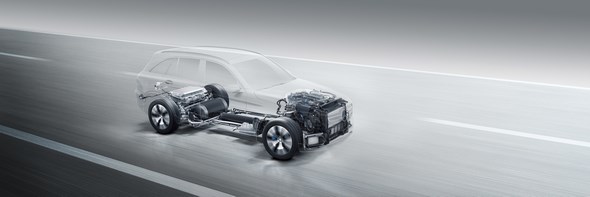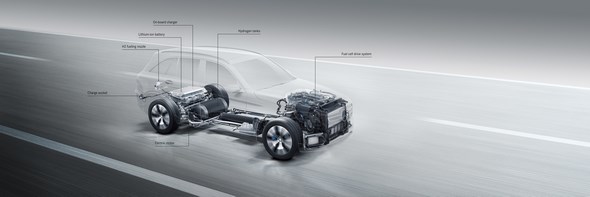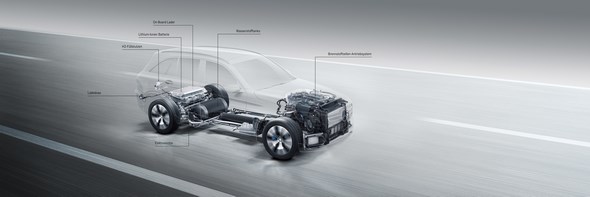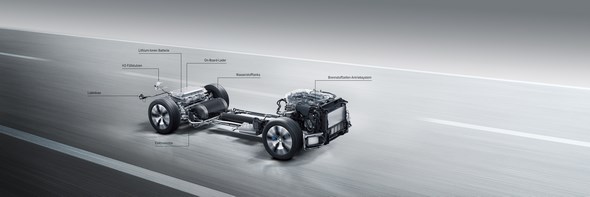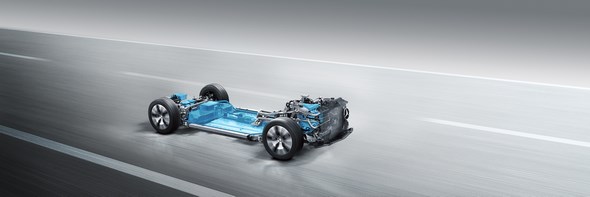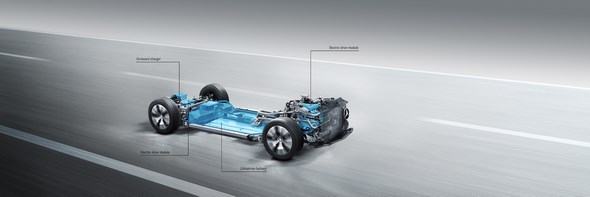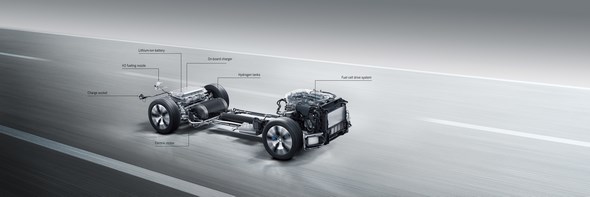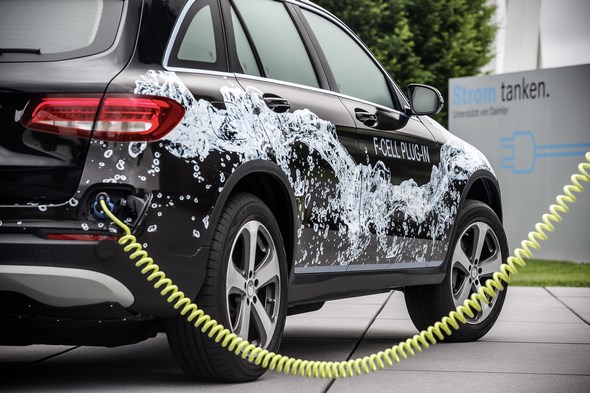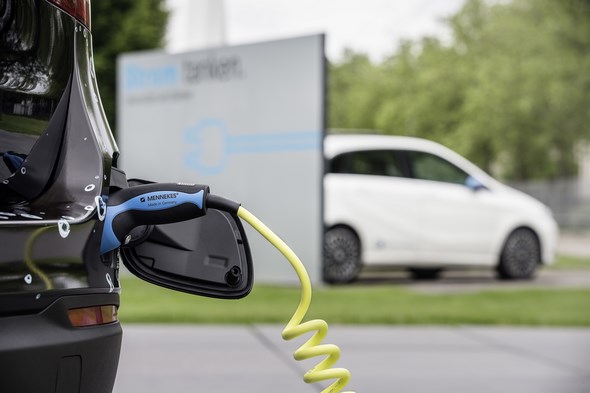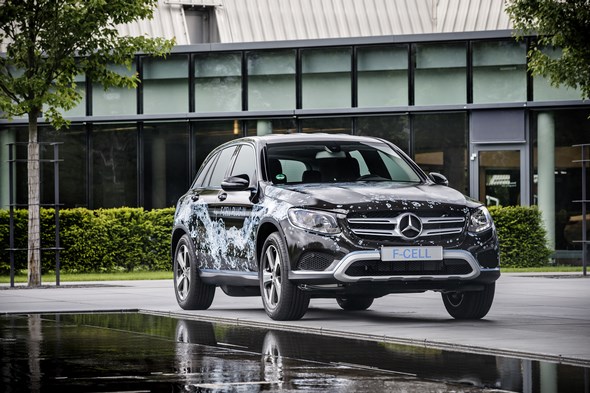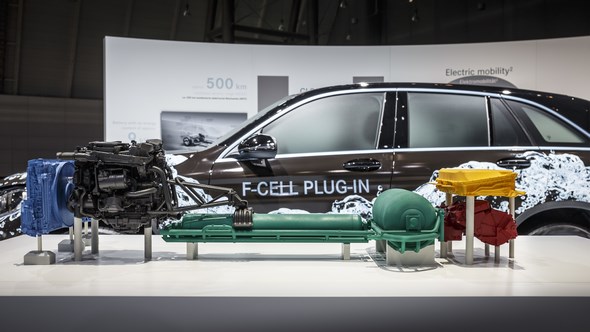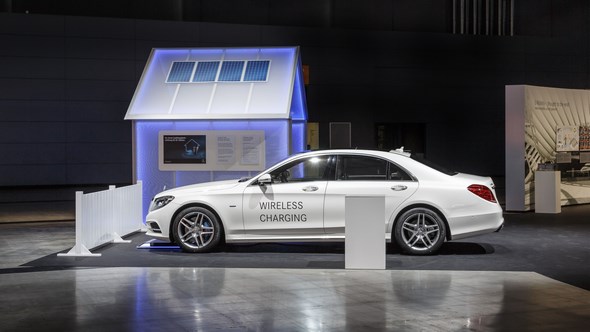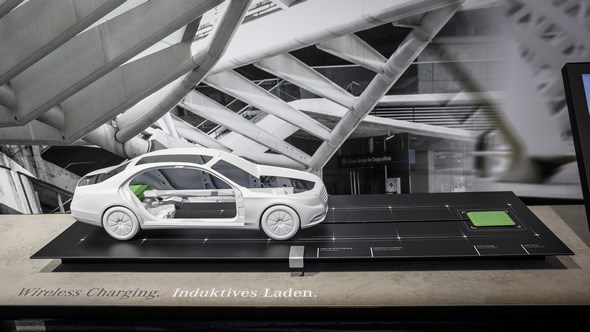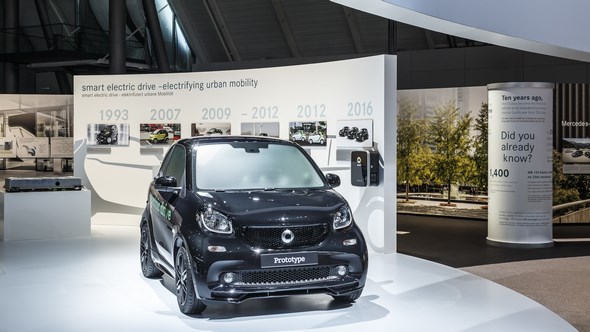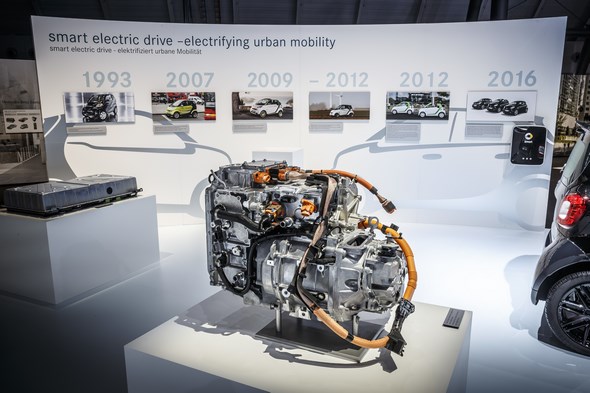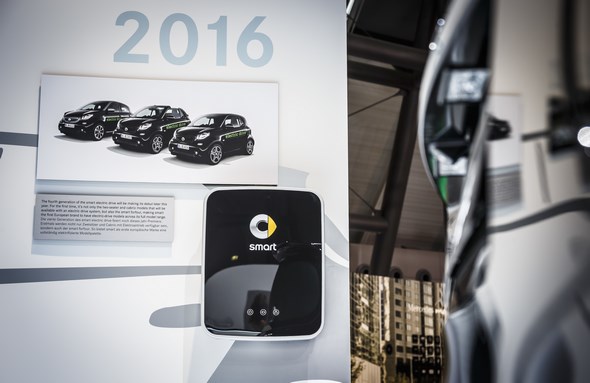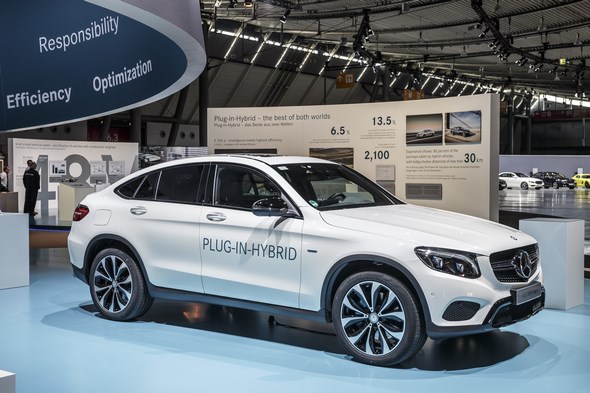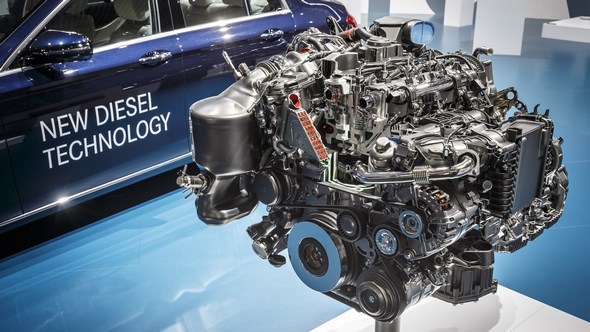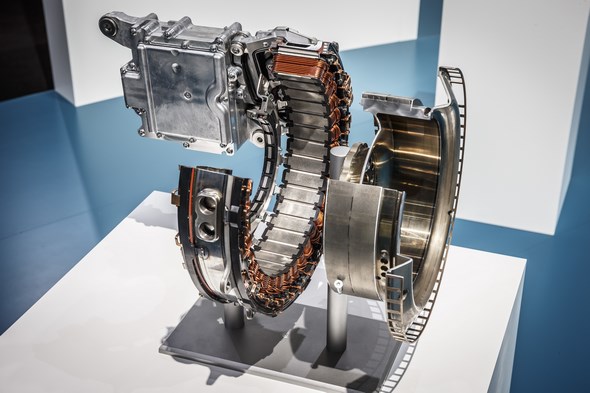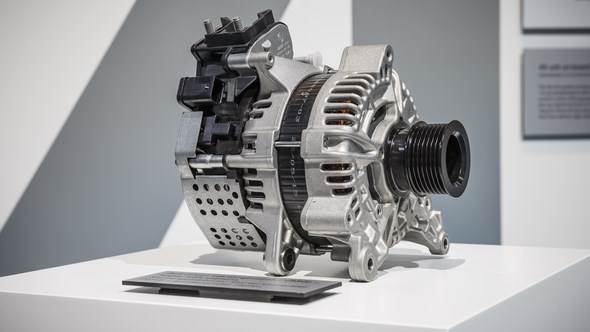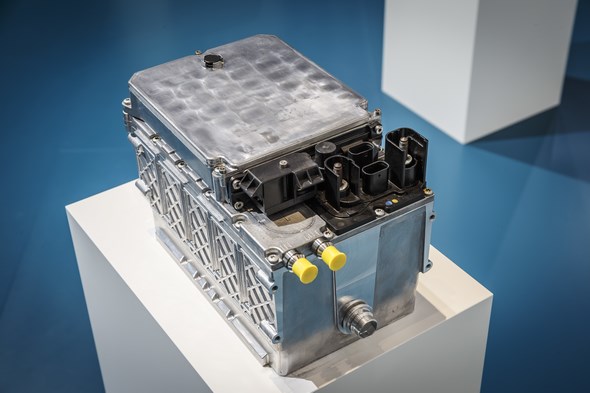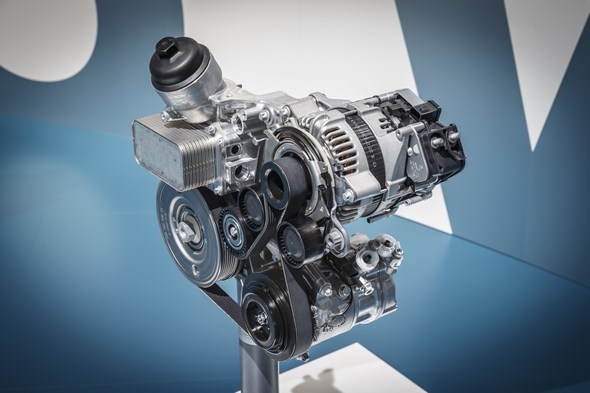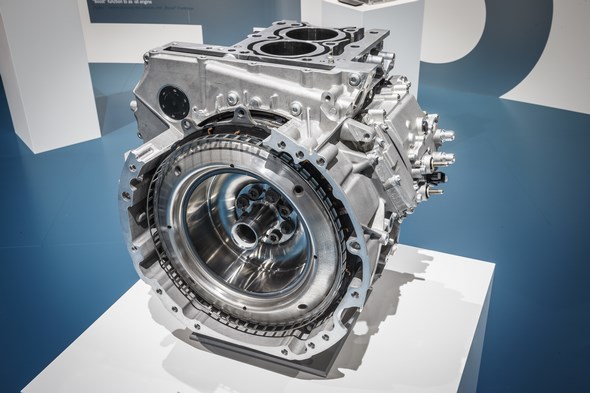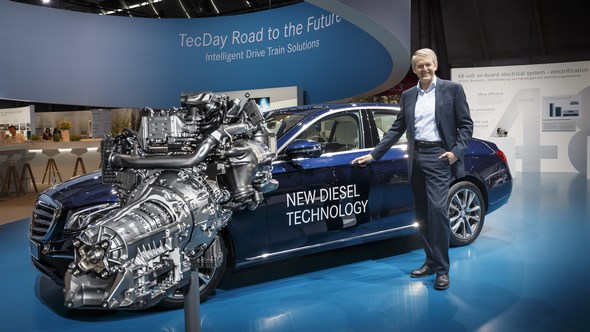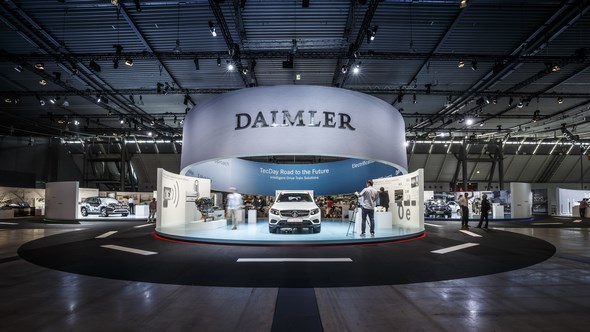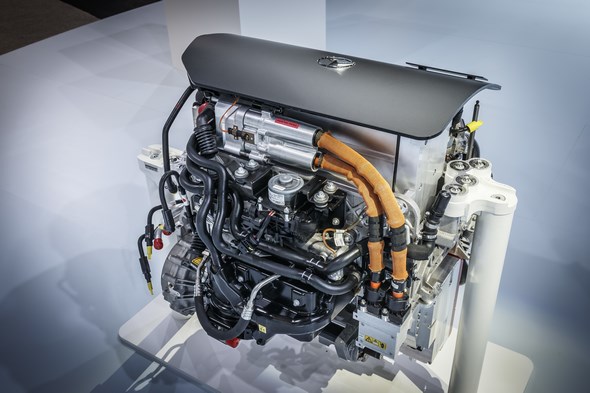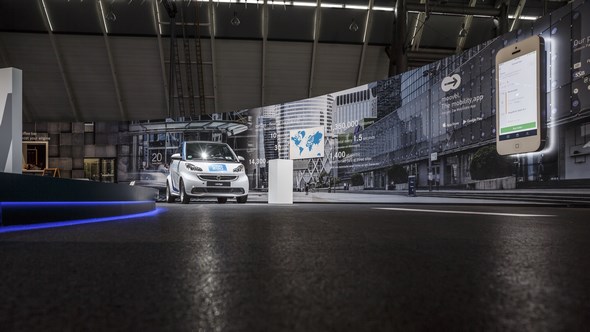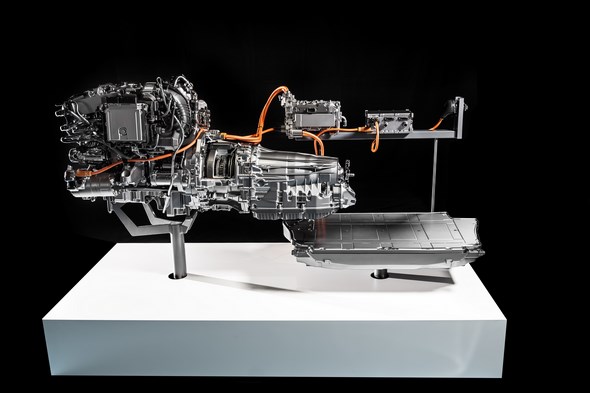Daimler invests massively in green powertrain technologies

All Mercedes-Benz model series will be electrified

Stuttgart. Daimler will invest more than seven billion euro in ‘green’ technologies in the next two years alone.
Shortly, smart will be the only automaker worldwide to offer its entire model range both powered by internal combustion engines or operating on battery power.
Mercedes-Benz will put the first fuel-cell-powered vehicle with plug-in technology into series production, the GLC F-CELL.
In addition, the company is developing a dedicated vehicle architecture for battery-electric motor cars.
Following the just presented new diesel engine generation, a new family of petrol engines is in the starting blocks for 2017, which will again set efficiency standards and will be the first ever to be equipped with a particulate filter.
The 48-volt on-board power supply will be introduced at the same time and starter-generators will become part of the standard specification.
It will make fuel savings possible that previously were the exclusive domain of the high-voltage hybrid technology. At the same time, the Mercedes-Benz plug-in hybrid initiative is in full swing: In the GLC Coupé 350 e 4MATIC and the E 350 e, models number seven and eight are poised to arrive in dealer showrooms still in 2016.
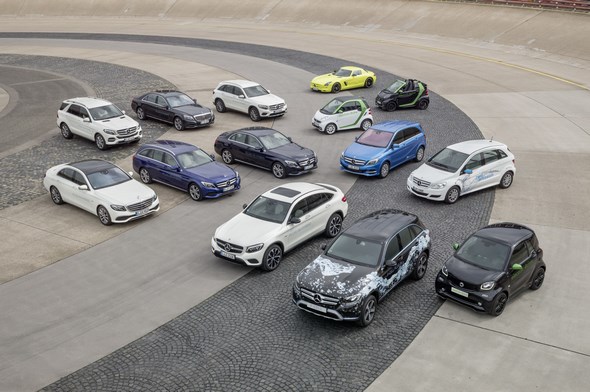
The next major technological leap will be made in 2017, starting with the model update of the S 500 e: for the first time, all-electric operating ranges exceeding 50 km will be made possible by an advancement of the lithium-ion battery together with a further optimised intelligent operating strategy.
“We will invest 14.5 billion euro in research and development in the next two years alone – more than half of it will again be spent on ‘green’ technologies.
Just for our passenger cars, we are talking about 5.4 billion euro”, says Prof Dr Thomas Weber, Member of the Board of Management of Daimler AG, Group Research and Mercedes-Benz Cars Development.
“As a matter of fact, no other manufacturer offers a comparable range of electrified vehicles and solutions in the field of electric mobility.
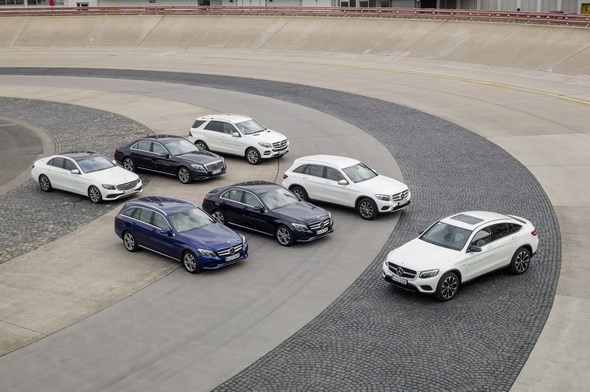
The spectrum ranges from the smart city runabout and attractive Mercedes-Benz passenger cars to buses, coaches, and trucks of the Fuso brand.
We will electrify all Mercedes-Benz passenger car model series step by step“.
Daimler deliberately opts not for a solitary type of powertrain for tomorrow’s mobility, but for a coexistence of different technologies.
These are optimally tailored to the particular customer needs and vehicle models. Thomas Weber: “Customers are not looking to sacrifice in the sense of ‘less car’ – in the contrary.
That is why we emphasise enhanced efficiency through more intelligent technology – and we do it consistently in all model series.
All the mentioned types of powertrains – gasoline, diesel, plug-in-hybrids, batteries or hydrogen – have their justification and chances”.
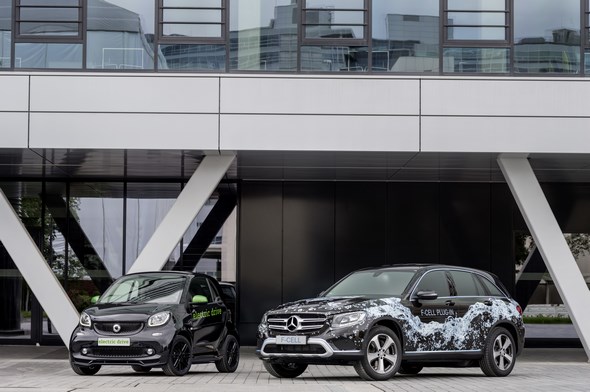
Road #1: High-efficiency internal combustion engines
Mercedes-Benz attaches key importance to the optimisation of modern internal combustion engines in its road map to sustainable mobility.
In particular, the economical, clean and, especially in Europe, highly popular diesel engine makes an important contribution to the further reduction of fleet consumption.
A new family of petrol engines that will again set efficiency standards is slated to follow in 2017. The 48-volt on-board power supply will be introduced at the same time.
It will make fuel savings possible that previously were the exclusive domain of the high-voltage hybrid technology.
Integrated starter generators (ISG) and belt-driven starter generators (RSG) are further components in enhancing the efficiency of internal combustion engines.
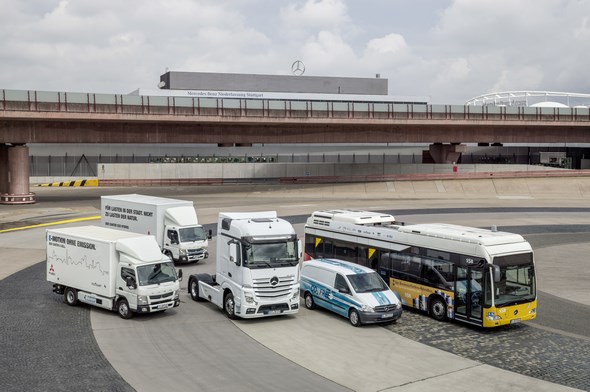
And what today is standard for diesel engines will also soon be used for petrol engines at Mercedes-Benz: the particulate filter.
Mercedes-Benz is on the right track. In two decades since 1995, the average consumption of the passenger car fleet dropped by nearly half from 9.2 l/100 km (230 g CO2 /km) to 5.0 l (123 g CO2/km).
Today, 62 models from Mercedes-Benz Cars already emit less than 120 g/km. And 104 models carry the efficiency label A+ or A.
With 88 models, diesel-powered vehicles account for a disproportionately large number of these efficiency champions.
The new family of premium diesel engines from Mercedes-Benz is therefore a powertrain of the future.
Following the début of the OM 654 in the E 220 d in spring of 2016, the family of engines will be widely used in the entire product range of Mercedes-Benz Cars and Vans in the medium term.
There are plans for several output variants as well as longitudinal and transverse installation in vehicles with front-, rear- and all-wheel drive.
Modular design, reduction in variants and standardisation of the interfaces between power unit and vehicle – this strategy was therefore logically also applied in the development of the new premium petrol engines from Mercedes-Benz.
The first representative, an in-line six-cylinder engine (M 256) with integrated starter generator (ISG), will be launched in 2017 and will set new benchmarks in efficiency.
The new family of engines will also include a four-cylinder engine with belt-driven starter generator (RSG) starting in 2017.
The introduction of the new engine generation once more blurs the lines between petrol and hybrid models.
Perspectively, all Mercedes-Benz passenger cars will be electrified, because the company is at the same time systematically advancing the development of the 48-volt on-board power supply.
The technology will be introduced in various model series step by step. The 48-volt on-board power supply offers four times the power of its 12-volt predecessor at unchanged currents, but without the additional safety architecture of a high-voltage system.
Furthermore, this low-voltage system makes fuel savings possible that previously were the exclusive domain of the high-voltage hybrid technology.
That is because the important hybrid functions “energy recovery”, “boost” and “starting off and manoeuvring in electric mode” can be realised for the first time without high-voltage components.
What has become the standard for diesel engines will also soon be used for petrol engines at Mercedes-Benz: the particulate filter. Mercedes-Benz is the first manufacturer planning the large-scale use of particulate filters also for petrol engines to further improve the environmental compatibility.
After more than two years of positive field experience in the S 500, additional variants of the S-Class powered by a petrol engine are to be equipped with this new technology as part of the model update as early as next year.
The filter will then be gradually introduced in other, new vehicle models, model updates and new engine generations. Thereafter, the use of the particulate filter is also planned for the current model series.
Road #2: The most extensive range of plug-in hybrids is further expanded
Plug-in hybrids represent a key technology on the road to a locally emission-free future for the motor car.
This is because they offer customers the best of both worlds; in the city they can drive in all-electric mode, while on long journeys they benefit from the combustion engine’s range.
Hybridisation also makes the internal combustion engine more efficient, and ensures more dynamic performance.
The Mercedes-Benz plug-in hybrid initiative is in full swing: following the S 500 e, C 350 e (Saloon, Estate and long-wheelbase version for China), the GLE 500 e 4MATIC and the GLC 350 e 4MATIC, models number seven and eight will arrive in dealer showrooms still in 2016, the GLC Coupé 350 e 4MATIC and the E 350 e.
Mercedes-Benz already has the widest range of plug-in hybrid models today. All in all, the hybrid range from Mercedes-Benz presently comprises 13 models.
In the E 350 e, the combination of the 9G-TRONIC plug-in-hybrid transmission and the latest generation of electric motors ensures top marks for fuel consumption, ride comfort and dynamics.
The next major technological leap will be made in 2017, starting with the facelift of the S 500 e: for the first time, all-electric operating ranges exceeding 50 km will be made possible by an advancement of the lithium-ion battery together with a further optimised intelligent operating strategy.
Because the strengths of plug-in hybrids come to the fore in larger vehicles and on mixed route profiles, Mercedes-Benz is opting for this powertrain concept from the C-Class on up.
The strategic hybrid initiative is decisively facilitated by Mercedes-Benz’s intelligent modular hybrid concept: It is scalable to allow it to be transferred to a large number of model series and body styles as well as left- and right-hand-drive variants.
Road #3: Electric pioneer Mercedes-Benz significantly expands carbon-free mobility
Reducing CO2 emissions across all vehicle categories is a top priority for Daimler AG. Electromobility has an important part to play in this regard.
The company already has a large number of electric vehicles on the market, and the product range is set to continue to grow. Prof Dr Weber: “We are investing massively in electromobility, and we are convinced that the market is now ready.
With the new vehicles we offer, we want to impress the benefits of the new mobility on car owners who have not yet opted for an electric vehicle.”
The smart fortwo electric drive made Daimler the first manufacturer to offer a series-produced electric vehicle in 2007.
Today, the company will soon have more than a dozen vehicles on the market including vans and commercial vehicles that are capable of emission-free driving.
The range is going to be significantly expanded in the near future. The fourth generation of the smart as a fortwo and also as a forfour for the first time ever is being launched onto the market before the end of the year.
The smart fortwo coupé electric drive, smart fortwo cabrio electric drive and smart forfour electric drive are making their global débuts at the Paris Motor Show in September 2016.
With the début of the fourth generation of the electric smart, smart will be the only automotive manufacturer in the world to offer its entire range of models either powered by internal combustion engines or operating entirely on battery power.
The new smart fortwo electric drive is being launched onto the US market by the end of this year, where approximately 25 percent of all battery-driven smarts have been sold recently.
This will be followed by the European market launch of the two- and four-seat models in early 2017.
This will be followed by the Mercedes-Benz GLC F-CELL with innovative plug-in fuel cell technology from 2017. Fuel-cell technology is an integral part of Daimler’s powertrain strategy.
The benefits are obvious: a long operating range and short refuelling stops as well as a broad spectrum of possible uses ranging from passenger cars to urban buses.
A new generation of vehicles is being launched from 2017 on the basis of the Mercedes-Benz GLC. The Mercedes-Benz engineers joined forces with partners in the Daimler network of expertise to develop a new, compact fuel-cell system which for the first time fits into conventional engine compartments.
The GLC F-CELL also boasts another innovation for the next generation of fuel cell vehicles in the form of a large lithium-ion battery.
Rated at around 9 kWh, the battery serves as an additional energy source for the electric motor and can be charged externally by means of plug-in technology for the first time.
The combination of the fuel cell and battery systems in concert with the refinement of the intelligent operation strategy offers the best possible efficiency and comfort.
With this set-up, the GLC F-CELL achieves a combined range of around 500 km in the NEDC.
Another important step is the development of a multi-model electric vehicle architecture for battery-powered vehicles. The first model is to be launched onto the market before the end of the decade.
The light-duty Fuso Canter E-Cell truck has been undergoing commercial fleet testing since 2015. This was initially carried out in Portugal where they are produced, and five of the vehicles have also been on the road for the City of Stuttgart and the logistics company Hermes since April this year.
Instead of a diesel, an electric powertrain with a strong permanent-magnet motor delivers an output of 110 kW (150 hp) to the rear axle via a single-speed transmission. 650 newton metres of torque allow the six-tonne vehicle to accelerate almost as fast as a passenger car, and are available from the very first second of driving.
Dozens of fuel cell-powered Mercedes-Benz Citaro buses have already been proving their mettle for twelve transport operators on three continents since 2003.
The next milestones on the way to the future are the Citaro E-CELL (battery-powered) and Citaro F-CELL (fuel cell-powered).
Both are based on a shared e-platform, which allows tailored electromobility for any city and even any bus line.
The capacity of the battery and charging technology are adjusted to suit the specific requirements. The forecast: By the year 2030, 70 percent of all newly acquired Citaro buses will run on electricity with zero local emissions.
Road #4: The mobility of the future will be more flexible and networked
Daimler has for years been developing from an automobile manufacturer into a mobility provider. The focus is no longer solely on the car as a product, but also on services related to mobility.
Charging made easy: Whether at home via a wallbox charging system, while shopping, at work or on the street: the possibilities for powering electric vehicles are already very diverse nowadays.
Daimler will shortly be offering an innovative solution, particularly for charging at home: Inductive charging will revolutionise charging convenience from 2017.
The use of the technology is initially planned for the facelift model of the Mercedes-Benz S 500 e. New for cable-connected charging, too: from 2018, direct current charging based on the CCS (Combined Charging System) standard will gradually find its way into all electric vehicles from Mercedes-Benz.
This will enable fast charging in public at a much greater capacity than is possible today.
For electric and plug-in vehicles, the services from Mercedes-Benz include the installation of the Mercedes-Benz wallbox charging system as well as exclusive Mercedes me connect functions.
Another aspect of the corporate strategy is to offer new, innovative services for flexible and networked mobility. moovel provides the fastest connection between two places, taking all means of transport into consideration.
With more than 1.3 million customers, car2go is the world’s leading carsharing company, and mytaxi is now used in 40 European cities.
Network of expertise: concentrated know-how on batteries and systems
In addition to its internal development and production expertise and its modular strategy for alternative powertrains, part of Daimler AG’s philosophy is to ensure that it has direct access to key components for electromobility.
Through its wholly owned subsidiary Deutsche ACCUMOTIVE, Daimler has extensive know-how when it comes to the development and production of highly complex drive batteries.
NuCellSys is a global leader in the development and manufacturing of fuel cell systems for vehicle applications.
The network of expertise also includes joint ventures, for example with Bosch for electric motors (EM-motive) and with Ford for fuel cell stacks (AFCC), but also as a partner with H2 Mobility GmbH in order to build up the hydrogen infrastructure.
Daimler AG already recognised at a very early stage that the availability of highly complex battery systems will continue to play an enormously important role for the automobile industry in the future.
With its subsidiary Deutsche ACCUMOTIVE founded in 2009, the company is the only German manufacturer today with its own battery production, and is currently expanding its capacities on a broad basis with an investment of 500 million euro.
The introduction of lithium-ion technology in 2009 brought the breakthrough in energy storage technology and thus made electromobility a reality.
In the same year, Mercedes-Benz was the first manufacturer worldwide to put a vehicle with this technology on the market, the S 400 Hybrid.
Today, all Mercedes-Benz plug-in hybrids and electric vehicles are based on it. Further technological leaps where batteries are concerned are expected in the coming decade through the launch of post-lithium-ion systems, with lithium-sulphur batteries currently being the most promising.
Daimler got involved in the new line of business with stationary battery storage systems in 2015, and has opened up additional opportunities to grow outside the automotive sector.
It recently founded the “Mercedes-Benz Energy GmbH” subsidiary, which is taking over the development and global distribution of stationary energy storage systems of the Mercedes-Benz brand with immediate effect.
Embase, a joint venture between Daimler AG, The Mobility House AG and GETEC, is set to commence operation of the world’s largest 2nd use battery storage system this year in Lünen in the Westphalia region of Germany.
Used systems from second-generation smart electric drive vehicles are combined to create stationary storage systems and marketed on the German primary energy balancing market.
Interview Prof. Dr. Thomas Weber
“Electric mobility at Daimler will be in the six figures by 2020”
Prof Dr Thomas Weber, 62, has been responsible for Daimler Group Research and Mercedes-Benz Cars Development for 12 years. This means he is involved in a key position in the ongoing largest technological transformation of the automobile in its 130-year history. In the interview, he summarises where we stand in powertrain development and provides a look ahead.
Professor Weber, petrol models, diesel models, plug-in hybrids, battery or hydrogen – is this confusing variety really necessary? Or a sign of disorientation?
Weber: It is a necessity. And that is precisely the reason why Daimler deliberately opted not for a solitary type of powertrain for tomorrow’s mobility, but for a coexistence of different technologies. These are optimally tailored to the particular customer needs and vehicle types. You have to remember that we have a vehicle range without equal. From microcars to heavy-duty transports, we cover all mobility requirements. And that requires us to see the whole picture. All types of powertrains you mentioned have their justification and chances. Customers are not looking to sacrifice in the sense of “less car”. That is why we emphasise enhanced efficiency through more intelligent technology – and we do it consistently across all model series.
Let us look at the individual alternatives. Does the diesel engine actually still have a future?
We are sure it does! Especially in Europe, diesel engines are the most economical and efficient alternative for those who drive a lot. Our new premium diesel models are more fuel efficient and more powerful, lighter and more compact than ever before – and they are designed to meet all future emission standards worldwide. Diesel engines in trucks and cars are indispensable if traffic-related CO2 emissions are to be cut further.
And the petrol engine?
It too has undergone a remarkable development in the last ten years, internal friction, variable valve timing, direct injection and turbocharging, just to name a few. And it will make further progress – with the introduction of petrol particulate filters as standard, and especially with the introduction of the 48-volt systems. Please keep in mind: We managed to cut the fuel consumption of our vehicle fleet practically by half within 20 years thanks to the rigorous advancement of the internal combustion engines.
We will continue on this path, because the internal combustion engine and electrification are not in competition with each other. They are perfect partners for many use cases. For example, the general weakness of petrol engines in the area of efficiency under partial load is overcome with the hybridisation and this blows the door for further downsizing wide open.
Are plug-in hybrids more than a technology to bridge the gap?
In any case, it’s a bridge that spans far into the future. Plug-in hybrid technology represents a significant efficiency gain and the possibility to drive locally emission-free without range restrictions. The possible distances will soon be considerably longer still in light of the rapid development of the battery technology. But above all, plug-in technology is the decisive and likewise mental entry into electric mobility. People will almost playfully learn necessary behaviour like regular charging.
This brings us to battery-powered electric vehicles. Their range is insufficient, charging takes too long and they cost too much – so the criticisms we hear every day. What’s your response?
You can blame a sports car for not offering room for nine, an RV for not fitting in an underground car park and a smart electric drive for not being suitable for driving from Hamburg to Rome. But that is misleading. An electric vehicle is certainly not the right answer yet for people who regularly drive long distances between cities or on the motorway. But who actually does that? In reality, the usage profile of many cars is actually quite different.
What does the usage profile look like from your point of view?
For instance, we take the children to school in the morning and then head on to work. The car is parked there for hours and the battery can be easily recharged – if the employer offers provides a possibility to do so. The commute is the same distance in the evening, even if take a little side trip to go shopping or stop for a workout. If you’re a motorist, ask yourself how many days a year you drive more than 50 or 100 kilometres at a stretch.
Nonetheless, people also want to go on vacation with their car or go visit grandma on Easter.
Of course. That is part of the freedom that we owe to the car and that we want to preserve. But let us look at reality in this regard as well: Many households have two or more vehicles and they don’t use the second car for these trips anyway – it could therefore also be electrically powered. I also see a major opportunity for carsharing or rental offers in this context: I become the temporary owner of a suitable vehicle for the great journey or the exceptional trip. We already do that today when we rent a Sprinter to move the children or an SLC for a tour of Scotland, for which we arrive by plane. Or an RV for a vacation in the USA.
But the question of the high purchase price still remains…
…and it is justified, at least in part. Especially in the early days, new technologies are always somewhat more expensive. But there are also a number of positive aspects when you buy an electric vehicle: low operating costs, low noise, lots of driving fun and of course less impact on the environment. Naturally, we see that electric mobility is not yet picking up steam as much as we would wish. That is why we also welcome, among other things, the initiative of the German Federal Government – and that of many other countries – to offer a bonus to create an additional incentive to join the technology transformation…
…because you will finally be in the black selling electric vehicles as a result?
Nothing could be further from the truth. There is one point especially that in my mind is getting a little bit lost in the discussion about the buying incentive: We welcome the state subsidy not because we make money from it in any way. Nobody makes a profit these days with electric vehicles – especially not the manufacturer, who is always held up as a shining example. The main issue is the public, shared commitment of industry and policymakers to electric mobility. This step will facilitate the breakthrough of electric mobility. At Daimler, we want electric mobility to spread more widely and are intensively working on making it ready for the broad masses. But in many respects, this goes beyond the advancement of our vehicles and technologies. Especially standardisation of the charging infrastructure plays a primary role.
What is in store for the battery technology? Do you expect technological breakthroughs in the coming years?
A lot will happen in this area in the coming years that will help us to drive farther and make electric mobility more affordable. Thanks to intensive research work, we see a doubling of the energy density in an unchanged installation space while the cost of batteries will be cut by half. With the introduction of the post-lithium-ion technology, of which the lithium-sulphur systems are currently the most promising, we will have an entirely different playing field in the next decade.
Automakers must realise fleet emissions of 95 grams of CO2 per kilometre by 2020. How many electric cars do you have to sell for Daimler to reach the target?
We have our eyes firmly on this target. We have taken a giant step in the development. Between 2014 and 2015, we cut our fleet average by 6 grams to 123 g/km. Our target for the MBC fleet in Europe is around 100 grams. We will steadily increase the percentage of electric vehicles in our fleet to reach this target. Electric mobility at Daimler will be in the six figures by 2020.
And vehicles with internal combustion engine and those with battery power will continue to build on the same platform?
Not exclusively. We are now at a point where we are also developing a dedicated vehicle architecture for purely battery-electric vehicles, in addition to the hybridised vehicle models and those powered by a fuel cell. This is another indication of our commitment to electric mobility. We are investing massively in electric mobility. We are convinced the market is now ready. This step will considerably increase the appeal and utility of electric vehicles further still.
What role is left for the fuel cell then?
The fact that the fuel cell powertrain is ready for market today is undisputed. We already demonstrated that back in 2011 with the Mercedes-Benz F-CELL World Drive. One thing is clear: battery technology also promises increasingly longer ranges at lower and lower costs. But the fuel cell will continue to have at least one clear advantage in future: long ranges with short refuelling times of just three minutes. The hydrogen technology is also and especially suitable for the bus sector, where there is particular strong demand from cities. The vision of a totally emission-free mobility based on hydrogen as energy source is alive and well. Today, its biggest handicap still is the necessity to establish an entirely separate infrastructure of filling stations. The concrete infrastructure build-up plans in many countries and not least in Germany drawn up by our H2 Mobility joint venture make us optimistic, however. We will make yet another statement with the market launch of our new fuel cell vehicle based on the GLC. In particular with its innovative technology, which we already showcased in our F 125! and F 015 research vehicles: With the F-CELL plug-in powertrain, we will expand the possibilities further still.
Personal details:
Prof Dr Thomas Weber has been a Member of the Board of Management of Daimler AG since 1 January 2003 and in this role responsible for Group Research and Mercedes-Benz Cars Development since 1 May 2014. He will retire at the end of 2016.
Thomas Weber was born on 26 May 1954 in Scharnhausen, Germany. After technical training at what was then Daimler-Benz AG, he studied mechanical engineering at Stuttgart University and graduated in 1980. He then went on to work as a research associate at Stuttgart University and the Fraunhofer Institute. He completed his doctorate at Stuttgart University in 1987 and joined former Daimler-Benz AG. In 2010, he was appointed Honorary Professor at Stuttgart University.
Previous positions at the company:
- Deputy Member of the Board of Management, Research and Technology, DaimlerChrysler AG, 2003
- Speaker of the Management Board A-Class and Head of the Rastatt Plant, DaimlerChrysler AG, 2002
- Head of the Rastatt Plant, DaimlerChrysler AG, 1999
- Centre Manager Mercedes-Benz Engine Production Stuttgart, DaimlerChrysler AG, 1998
- Head of the Bad Cannstatt Engine Plant, Daimler-Benz AG, 1995
- Project New V-Engine Generation, Daimler-Benz AG, 1994
- Assistant to the Board of Management Passenger Car Production and Commercial Vehicle Development, Mercedes-Benz AG, 1991
- Planning Engine Production, Untertuerkheim Plant, Daimler-Benz AG, 1987
Road #1: Diesel Engines, Petrol Engines, ISG and RSG, 48-Volt On-Board Power Supply
High-efficiency internal combustion engines: Everything old is new
Mercedes-Benz attaches key importance to the optimisation of modern internal combustion engines in its road map to sustainable mobility.
In particular, the economical, clean and, especially in Europe, highly popular diesel engine makes an important contribution to the further reduction of fleet consumption.
A new family of petrol engines that again will set efficiency standards is set to follow in 2017. The 48-volt on-board power supply will be introduced at the same time.
It will make fuel savings possible that previously were the exclusive domain of the high-voltage hybrid technology.
Integrated starter generators (ISG) and belt-driven starter generators (RSG) are further components in enhancing the efficiency of internal combustion engines.
And what has long since been a must for diesel engines will soon also be used for petrol engines: the particulate filter.
Mercedes-Benz is on the right track. In the two decades since 1995, the average consumption of the passenger car fleet has dropped by nearly half from 9.2 l/100 km (230 g CO2 /km) to 5.0 l (123 g CO2/km).
Today, 62 models from Mercedes-Benz Cars already emit less than 120 g/km. And 104 models carry the efficiency label A+ or A. With 88 models, diesel-powered vehicles account for a disproportionately large number of these efficiency champions.
The new family of premium diesel engines from Mercedes-Benz is therefore a powertrain of the future.
Following the début of the OM 654 in the E 220 d in spring of 2016, the family of engines will be widely used in the entire product range of Mercedes-Benz Cars and Vans in the medium term.
There are plans for several output variants as well as longitudinal and transverse installation in vehicles with front-, rear- and all-wheel drive.
Modular design, reduction in variants and standardisation of the interfaces between powertrain unit and vehicle – this strategy was therefore logically also applied in the development of the new petrol engines from Mercedes-Benz, which complete the family of premium engines.
The first representative, an in-line six-cylinder engine (M 256) with integrated starter generator (ISG), will be launched in 2017 and will set new benchmarks in efficiency.
The new family will also include a four-cylinder engine with belt-driven starter generator (RSG) starting in 2017.
New-generation starter generators: untiring helpers
The belt-driven starter generator (RSG) is coupled with the internal combustion engine like the alternator is today.
The combination of starter motor and generator assists the internal combustion engine when starting, accelerating and recovering energy.
It uses existing alternator mounts and thus does not impact the design of the powertrain. The conversion to a 48-volt system is also relatively easy to realise on existing platforms with RSG.
The integrated starter generator (ISG) combines the starter motor and the generator in one powerful electric motor that is installed between engine and transmission and is also used for cold starts.
It replaces both the existing alternator and the starter motor. The integrated electric motor assists the internal combustion engine, for example when accelerating, and supplies the battery with power by means of high-efficiency energy recovery.
Especially in combination with a 48-volt battery, the necessary adaptations of the powertrain architecture pay long-term dividends in the form of higher fuel savings.
48-volt on-board power supply: a host of fuel-economy and comfort advantages
The introduction of the new engine generation once more blurs the lines between petrol and hybrid models.
Perspectively, all Mercedes-Benz passenger cars will be electrified, because the company is at the same time systematically advancing the development of the 48-volt on-board power supply.
The technology will be introduced in various model series step by step. The 48-volt on-board power supply offers four times the power of its 12-volt predecessor at unchanged currents, but without the additional safety architecture of a high-voltage system.
Furthermore, this low-voltage system makes fuel savings possible that previously were the exclusive domain of the high-voltage hybrid technology.
That is because the important hybrid functions “energy recovery”, “boost” and “starting off and manoeuvring in electric mode” can be realised for the first time without high-voltage components.
In addition, the durability of such a starter concept is so good that the engine can be switched off much more often and thus any time it is not needed: when coasting to a stop or when sailing, a fuel-saving rolling at higher speeds, as soon as the driver lifts off the accelerator.
The integration of a 48-volt on-board power supply also offers advantages for electrical consumers in the vehicle such as the climate control system, electric heating elements or the extractor fan.
At identical power, the electric currents are only one fourth of those in conventional systems. This means that the wiring can have a thinner and thus lighter design – which indirectly contributes to saving fuel.
Apart from reduced fuel consumption and CO2 emissions, the 48-volt on-board power supply also brings increased comfort.
That is because a 48-volt on-board power supply is able to rev up an internal combustion engine to idle speed very smoothly.
This benefits the NVH characteristics (Noise, Vibration, Harshness) and the transition during engine start becomes even more imperceptible: the engine just runs again as if it had never been off.
The 48-volt on-board power supply also paves the way for the further expansion of infotainment and assistance systems.
Particulate filter for petrol models: series-production use at Mercedes-Benz in 2017
What has become the standard for diesel engines will also soon be used for petrol engines at Mercedes-Benz: the particulate filter. Mercedes-Benz is the first manufacturer planning the large-scale use of particulate filters also for petrol engines to further improve the environmental compatibility.
After more than two years of positive field experience in the S 500, additional variants of the S-Class powered by a petrol engine are to be equipped with this new technology as part of the model update as early as next year.
The filter will then be gradually introduced in other, new vehicle models, model updates and new engine generations. Thereafter, the use of the particulate filter is also planned for the current model series.
Under the microscope: New family of premium diesel engines
More economical and powerful, more lightweight and compact
The new four-cylinder OM 654 diesel engine marks the début of a ground-breaking family of engines from Mercedes-Benz.
It is the first passenger car diesel engine to use the stepped-bowl combustion process – named after the shape of the combustion bowl in the piston.
The innovations furthermore include the combination of aluminium case and steel pistons as well as the further advanced NANOSLIDE® cylinder wall coating.
The new four-cylinder OM 654 engine celebrated its world première as the 220 d in the new E-Class in spring 2016. Installed in a comparable vehicle, the new engine consumes around 13 percent less fuel than its predecessor.
Alongside optimised airflow on the intake and exhaust sides and the use of fourth-generation common-rail injection with pressures up to 2050 bar, the fuel saving is due to a reduction in internal friction by around 25 percent. This was achieved by
- flat steel pistons with innovative stepped combustion bowls and long connecting rods
- extensive measures for friction reduction such as NANOSLIDE® coating of the cylinder walls
- offset of the crank assembly
- reduced displacement
- systematic lightweight design
Unusual combination: aluminium crankcase and steel pistons
At first glance, the combination of an aluminium crankcase and steel pistons appears unusual, because steel expands less than aluminium when hot, conducts heat less well and is heavier.
This explains why aluminium pistons have been used to date. Yet the Stuttgart engine designers have succeeded in turning these seeming disadvantages into advantages.
As an example, the lesser expansion of steel as operating temperatures rise ensures increasing clearance between piston and aluminium crankcase, reducing friction by 40 to 50 percent.
At the same time, the fact that steel is stronger than aluminium allows very compact, lightweight pistons that even offer additional strength reserves.
Finally, the lower heat conductivity of steel leads to higher component temperatures, thereby improving thermodynamic efficiency, increasing combustibility and reducing combustion duration.
The combination of innovative steel pistons with further refined NANOSLIDE® cylinder wall coating results in a reduction in consumption and CO2 emissions of up to four percent.
At lower and medium engine speeds, which play an important part in everyday motoring, the reduction in fuel consumption is even more pronounced.
World première in a passenger car: the stepped-bowl combustion process
Making its début in a passenger-car diesel engine, the new OM 654 employs the Mercedes-Benz stepped-bowl combustion process – named after the shape of the combustion bowl in the piston.
The combustion system has been completely redesigned. The stepped bowl has a positive effect on the combustion process, the thermal loading of critical areas of the pistons and the introduction of soot into the engine oil.
The efficiency is increased by the higher burning rate in comparison with the previous omega combustion bowl.
The characteristic feature of the specifically configured combination of bowl shape, air movement and injector is its very efficient utilisation of air, which allows operation with very high air surplus.
This means that particulate emissions can be reduced to an especially low level.
Exhaust emissions: all set for the future
The new diesel engine is designed to meet future emissions legislation (RDE – Real Driving Emissions). All components of relevance for efficient emissions reduction are installed directly on the engine.
Supported by insulation measures and improved catalyst coatings, there is no need for engine temperature management during cold starting or at low load.
In addition to the advantages in terms of emissions, this results in fuel savings, especially on short journeys.
Thanks to the near-engine configuration, exhaust aftertreatment has a low heat loss and optimal operating conditions.
The new engine is equipped with multi-way exhaust gas recirculation (EGR). This combines cooled high-pressure and low-pressure EGR.
This makes it possible to significantly further reduce the untreated emissions from the engine across the entire engine mapping, with the centre of combustion being optimised for fuel economy.
The production of the OM 654 takes place at the main factory in Untertürkheim, and at the wholly owned Daimler subsidiary MDC Power in Kölleda.
Road #2: Hybrid vehicles
Already the widest range of plug-in-hybrids
The Mercedes-Benz plug-in-hybrid initiative is fully under way: following the S 500 e, C 350 e (Saloon, Estate and long version for China), the GLE 500 e 4MATIC and the GLC 350 e 4MATIC, models seven and eight will already be in dealer showrooms by the end of 2016, in the form of the GLC Coupé 350 e 4MATIC and the E 350 e.
Mercedes-Benz already has the widest range of plug-in-hybrid models. All in all the hybrid portfolio from Mercedes-Benz presently comprises 13 models.
In the E 350 e, the combination of the 9G-TRONIC plug-in-hybrid transmission and the latest generation of electric motors ensures top rankings for fuel consumption, ride comfort and dynamism.
The next major technological leap will be made in 2017, starting with the facelift of the S 500 e: for the first time, fully electric operating ranges exceeding 50 km will be made possible by a further development of the lithium-ion battery together with a further optimised, intelligent operating strategy.
Plug-in-hybrids represent a key technology on the road to a locally emission-free future for the car. This is because they offer customers the best of both worlds; in the city they can drive in all-electric mode, while on long journeys they benefit from the combustion engine’s range.
Hybridisation also makes the internal combustion engine more efficient, and ensures more dynamic performance.
As the strengths of plug-in-hybrids come to the fore in larger vehicles with mixed operating profiles, Mercedes-Benz is opting for this drive concept from the C-Class upwards.
The strategic hybrid initiative is decisively facilitated by Mercedes-Benz’s intelligent modular hybrid concept: this is scalable to allow it to be transferred to a large number of model series and body versions as well as left and right-hand drive variants.
Latest plug-in-hybrid generation in the Mercedes-Benz E 350 e
The Mercedes-Benz E 350 e will be launched before the end of 2016 with no less than two technological world premieres: the combination of the 9G-TRONIC plug-in-hybrid transmission and the latest generation of electric motors ensures top rankings for fuel consumption, ride comfort and dynamism.
The E 350 e is also the first hybrid from Mercedes-Benz with a high trailer towing capacity of up to 2,100 kg.
The third-generation hybrid transmission evolved on the basis of the 9G-TRONIC PLUS automatic transmission.
The torque converter, clutch and electric motor are housed in the innovative hybrid drive unit. The remarkably compact design has been achieved by integrating and connecting the clutch, torsional vibration damper and torque converter lock-up clutch within the rotor of the electric motor.
The newly developed torque converter with its powerful and highly efficient hydraulic circuit offers the customary outstanding smoothness when pulling away in hybrid mode.
Developed together with Bosch as part of the EM Motive joint venture, the electric motor was specially designed for the 9G-TRONIC plug-in-hybrid transmission.
In combination with the likewise new and much more efficient power electronics, it was possible to further increase output and torque to 65 kW and 440 Nm respectively.
This is 5 kW more output and 100 Nm more torque compared to the preceding system in the C 350 e.
This high level of torque is instantly available from stationary, and allows tremendous agility when pulling away, plus sporty driving characteristics.
Further improvements to the intelligent operating strategy also increase the efficiency of the hybrid. The new thermal management links the vehicle’s cooling system with the navigation data, and predictively balances out temperature peaks by advance cooling.
The recuperation function was also improved in the E 350 e: energy recovery not only sets in when approaching a slower-moving vehicle, but also before entering speed limits or on downhill gradients.
Depending on the driving profile, the business saloon is able to cover 18 up to 33 km with no emissions, consuming just 2.1 litres of fuel per 100 kilometres (NEDC).
Intelligent operating strategy and special comfort and efficiency systems
The innovative hybrid traction head with clutch electric motor and converter in combination with the intelligent operating strategy allows the system to achieve the optimum comfort and efficiency in all driving situations.
- When the hybrid model is driving fully electrically, the clutch is disengaged while the internal combustion engine is decoupled and switched off.
- The clutch likewise remains disengaged during energy recuperation, the electric motor then acting as a generator and using the flywheel mass to charge the battery.
- The clutch is engaged during boost and sailing operation, or in Charge mode, and the intelligent hybrid control system actuates the electric motor according to current power requirements.
- The clutch remains engaged when driving with the internal combustion engine alone, and the intelligent hybrid control system switches the electric motor to free-running mode.
All the plug-in-hybrids have the following operating modes:
- Hybrid: All hybrid functions, such as electric mode, boost and recuperation are available and are deployed for optimum fuel efficiency.
- E-mode: used for all-electric driving – for example in inner-city areas or because the battery holds sufficient charge for the remainder of the journey.
- E-save: the charge status of the battery is maintained – for example to allow all-electric driving in an environmental zone at a later stage in the journey.
- Charge: Serves to charge the battery via the combustion engine while on the move, to enable all-electric driving in an environmental zone at a later stage in the journey, for example.
Special functions also improve comfort and efficiency:
- Silent start: the vehicle starts virtually silently and runs in electric mode. At this point the combustion engine is generally kept switched off.
- Boosting: The internal combustion engine is assisted with extra output by switching on the electric motor.
- Energy recuperation: Energy is recovered during braking, and fed to the battery. This energy can then be used at a later stage for electric driving or the boost function.
- Haptic accelerator pedal: Supports fuel-efficient driving. A resistance point indicates the maximum available electric output. A double impulse signals that the driver should remove their foot from the accelerator pedal in order to switch off the combustion engine and decouple it from the drive train.
- Intelligent drive management: Intelligent operating strategy for hybrid vehicles, anticipates the course of the road and the traffic situation for maximum efficiency. This includes radar-based recuperation, an anticipatory shifting and operating strategy, a route-based operating strategy and ECO Assist.
- Pre-entry climate control: The desired interior climate can be set before starting the journey – cooling in the summer, heating in the winter. This function can be activated via a pre-set departure time or via smartphone using the Mercedes me connect app.
- Retrieval of vehicle status: It is additionally possible to control the charging process or check the charge status and the current electric range via the Mercedes me connect app.
Enthusiastic: customers testing hybrid vehicles in day-to-day operation
In 2015, with a detailed customer survey, the Customer Research Centre at Mercedes-Benz established what expectations drivers of luxury cars have of hybrid vehicles, and how they assess them in day-to-day operation.
25 customers covering an average annual mileage of 30,000 kilometres were given the opportunity to drive a Mercedes-Benz S 500 in day-to-day use for two weeks.
Just under half of these customers had already experienced hybrid models during a test drive or short-term rental, but none of the test subjects, average age 53 years, had any longer day-to-day driving experience with them.
Three interviews were conducted with each of the participants in the study – before vehicle handover, after one week of use and when returning the test car.
This enabled the personnel at the Customer Research Centre to evaluate acceptance of plug-in-hybrids over a period of time and depending on use.
These are the major results of the study:
- The level of satisfaction with all-electric driving is high (in every type and mode of operation), and even tends to increase with day-to-day use.
- The acceptance of plug-in specific controls and displays is very high.
- The haptic accelerator pedal is highly appreciated in day-to-day driving.
- Electric operating range is an important purchase criterion, but after their day-to-day driving experience the participants in the study wished for less range than before.
- There is time available for charging in the customers’ daily routine: after a journey, the car is usually parked in a garage, multi-level car park or public car park for two to four hours.
- Mercedes me connect is very well received, and the enthusiasm only increases with actual use. The most used functions are the charge indicator, preconditioning and charge status.
Plug-in-hybrids: the success technology of the next decade
During the development of plug-in-hybrids, the engineers at Mercedes-Benz place particular importance on a balance between comfort, spaciousness, weight and electric operating range.
With maximum electric ranges of around 30 km, the Mercedes-Benz plug-in-hybrids already routinely cover many day-to-day driving distances under purely electric power, and therefore locally emission-free, and offer their users maximum efficiency and comfort in hybrid operation.
Advances in battery technology are the key to longer electric operating ranges for future plug-in-hybrids and electric vehicles.
This is why Daimler AG already began its own development and production of lithium-ion battery systems in 2009. It means that customers directly benefit from the latest developments.
Starting with the facelift of the S 500 e, Mercedes-Benz will present the next generation of its plug-in-hybrid technology from 2017.
A further development of the lithium-ion battery will have a rated capacity of up to 13.3 kWh, and in combination with the further improved, intelligent operating strategy this will allow electric operating ranges of over 50 km for the first time.
The highly efficient battery system comes from the wholly-owned Daimler subsidiary Deutsche ACCUMOTIVE, which will for the first time also be supplying accumulators for plug-in-hybrids from Mercedes-Benz.
It is expected that further progress in battery technology will continue to gradually increase battery capacity and therefore operating range.
From the C-Class to the S-Class: The current hybrid models
Plug-in-hybrid models are highlighted in light-grey
| C 350 e1 | C 300 h1 | GLC 350 e 4MATIC2 | |
| Number of cylinders/arrangement | 4/in-line | 4/in-line | 4/in-line |
| Displacement (cc) | 1991 | 2143 | 1991 |
| Rated output (kW/hp at rpm) | 155 (211) at 5500 | 150 (204) at 3800 | 155 (211) at 5500 |
| Rated torque (Nm at rpm) | 350 at 1200-4000 | 500 at 1600-1800 | 350 at 1200-4000 |
| Rated output of electric motor (kW at rpm) | 60 at 2000 | 20 at 1800 | 85 at 3.500 |
| Max. rated system output (kW/hp at rpm) | 205 (279) at 5000 | 150 (204) + 20 (27) | 235 (320) at 5000 |
| Max. system torque (Nm) | 600 | 500 + 250 | 560 |
| NEDC fuel consumption (l/100 km) combined | 2.1 S | 3.6 D | 2.5 S |
| Combined CO2 emissions (g/km) | 49 | 99 | 59 |
| Efficiency class | A+ (A+) | A+ (A+) | A+ |
| Acceleration 0-100 km/h (s) | 5.9 (6.2) | 6.4 (6.7) | 5.9 (5.9) |
| Top speed (km/h) | 250 (246) | 244 (238) | 235 (235) |
| Price from (euros)3 | 51,051 (52,717) | 47,243 (48,909) | 52,717 (n.a.) |
Figures in brackets for 1Estate, 2Coupé. 3recommended retail price in Germany incl. 19 % VAT. n.a.: not applicable
| E 350 e | GLE 500 e 4MATIC | |
| Number of cylinders/arrangement | 4/in-line | 6/V |
| Displacement (cc) | 1991 | 2996 |
| Rated output (kW/hp at rpm) | 155 (211) at 5500 | 245 (333) at 5250-6000 |
| Rated torque (Nm at rpm) | 350 | 4800 at 1600-4000 |
| Rated output of electric motor (kW at rpm) | 65 at 2.250 | 85 at 3500 |
| Max. rated system output (kW/hp at rpm) | 210 (286) at 3800-5500 | 325 (442) at 5250-5500 |
| Max. system torque (Nm) | 550 | 650 |
| NEDC fuel consumption (l/100 km) | 2.1S | 3.3 S |
| Combined CO2 emissions (g/km) | 49 | 78 |
| Efficiency class | A+ | A+ |
| Acceleration 0-100 km/h (s) | 6.2 | 5.3 |
| Top speed (km/h) | 250 | 245 |
| Price from (euros)1 | n/a | 74,196.50 (n.a.) |
1recommended retail price in Germany incl. 19 % VAT. n.a.: not applicable
| S 300 h1 | S 400 h1 | S 500 e | |
| Number of cylinders/arrangement | 4/in-line | 6/V | 6/V |
| Displacement (cc) | 2143 | 3498 | 2996 |
| Rated output (kW/hp at rpm) | 150 (204) at 3800 | 225 (306) at 6500 | 245 (333) at 5250-6000 |
| Rated torque (Nm at rpm) | 500 at 1600-1800 | 370 at 3500-5250 | 480 at 1600-4000 |
| Rated output of electric motor (kW at rpm) | 20 at 1800 | 20 at 1800 | 85 at 3500 |
| Max. rated system output (kW/hp at rpm) | 150 (204) + 20 (27) | 225 (306) + 20 (27) | 325 (442) at 5250-5500 |
| Max. system torque (Nm) | 500 + 250 | 370 + 250 | 650 at 1000-4750 |
| NEDC fuel consumption (kg/100 km) | 4.3 D | 6.0 S | 2.8 S |
| Combined CO2 emissions (g/km) | 110 | 139 | 65 |
| Efficiency class | A+ | A+ | A+ |
| Acceleration 0-100 km/h (s) | 7.6 | 6.8 | 5.2 |
| Top speed (km/h) | 240 | 250 | 250 |
| Price from (euros)2 | 87,762.50 (82,229) | 93,534 (87,643.50) | 110,253.50 |
1figures in brackets for short-wheelbase versions. 2 Recommended retail price in Germany incl. 19% VAT.
Under the microscope: charging technology
Charging made easier
Whether at home via a wallbox, while shopping, at work or on the street: the possibilities for powering electric vehicles are already very diverse nowadays.
Daimler will shortly be offering an innovative solution, particularly for charging at home: inductive charging is set to revolutionise charging convenience from 2017.
The use of the technology is initially planned for the facelift model of the Mercedes-Benz S 500 e.
News for cable-connected charging, too: from 2018, direct current charging based on the CCS (Combined Charging System) standard will gradually find its way into all electric vehicles from Mercedes-Benz.
This will enable fast charging in public with much greater performance than is possible today.
One of the next steps on the road to the perfect electric vehicle and plug-in-hybrid is wireless charging. Inductive charging makes handling these vehicles even more convenient.
Mercedes-Benz has been testing the contactless charging technology since 2015 with a test fleet of the current S 500 e.
From 2017 the technology should be ready: with the facelift model of the S 500 e, the availability of an inductive charging system as an optional extra is planned, in addition to cable-connected charging.
With this innovative technology, the electrical energy is contactlessly and safely transmitted via a magnetic field.
The system is comprised of two components: a secondary coil in the vehicle floor and a base plate with integrated primary coil.
This is placed on the garage floor, for example, or in a protected area in front of a carport. Via a display message in the cockpit the driver can see whether the vehicle is in the tolerance range over the charging station.
As soon as the charging position has been reached, charging automatically begins and is constantly monitored by the system.
The electrical energy is transmitted contactlessly, without a charging cable, at a power output of up to 3.6 kW.
With an efficiency rate of almost 90 percent, the high-voltage battery can be efficiently, conveniently and safely charged.
AC + DC = Combined Charging System (CCS)
Public fast charging is increasingly gaining in importance. In the past years, Daimler, in conjunction with other automotive manufacturers, has decisively advanced the development of the Combined Charging System into an open and universal charging system for electric vehicles.
The system pursues the goal of unlimited, global e-mobility. It expands the existing technical standard for AC charging of electric vehicles with the capacity for DC fast charging.
From 2018 direct current charging based on the CCS standard will gradually find its way into all electric vehicles from Mercedes-Benz.
Depending on the vehicle and battery system, this enables a charging capacity of up to 150 kW at fast charging stations. Perspectively, the system also enables a charging capacity of up to 350 kW.
Agreement on the European socket standard simultaneously simplifies the development of an extensive fast charging network.
In Germany, partners from business, politics and research are involved in the development of this infrastructure: in public projects such as “SLAM – Schnellladenetz für Achsen und Metropolen” (Fast Charging Network for Transport Axes and Metropolitan Regions) or “Schnellladen Berlin” (Fast Charging Berlin) the partners are driving forward the development of a fast charging network within Germany across all industries.
The German government has just decided to support the further development of a nationwide network of fast charging and normal charging stations with 300 million euros.
Road #3: Electric Mobility
Electric pioneer Mercedes-Benz significantly expanding CO2-free mobility
The smart fortwo electric drive made Daimler the first manufacturer to offer a series-produced electric vehicle in 2007.
Today the company will soon have more than a dozen vehicles on the market (including vans and commercial vehicles) that are capable of driving emissions-free.
The range is going to be significantly expanded in the near future. The fourth generation of the smart as a fortwo and also as a forfour for the first time ever is being launched onto the market before the end of the year.
This will be followed by the Mercedes-Benz GLC F-CELL with innovative plug-in fuel cell technology from 2017.
Another important step is the development of a multi-model electric vehicle architecture for battery-powered vehicles.
The first model is to be launched onto the market before the end of the decade.
Reducing CO2 emissions across all vehicle classes is a top priority for Daimler AG. Electromobility has an important part to play in this regard.
The company already has a large number of electric vehicles on the market, and the product portfolio is set to continue growing. Prof. Dr Thomas Weber, Member of the Daimler Board of Management, Group Research and Mercedes-Benz Cars Development: “Our road map has been clearly defined.
In addition to hybridized vehicle models and vehicles powered by fuel cells, we are now taking the next step and using a dedicated vehicle architecture for purely battery-driven vehicles.
We are investing heavily in electromobility, and we are convinced that the market is now ready. With the new vehicles we offer, we want to impress the benefits of the new mobility on car owners who have not yet opted for an electric vehicle.”
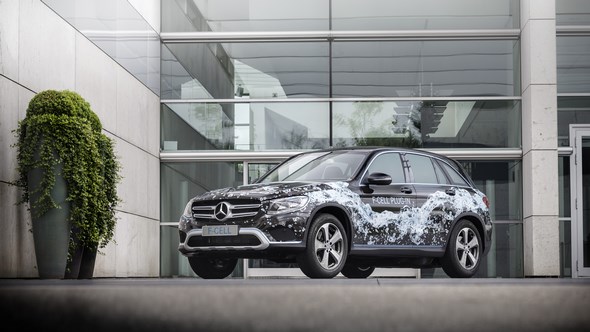
smart: Complete range of vehicles available with electric propulsion from 2017
The smart fortwo coupé electric drive, smart fortwo cabrio electric drive and smart forfour electric drive are making their global debuts at the Paris Motor Show in September 2016.
With the debut of the fourth generation of the electric smart, smart will be the only automotive manufacturer in the world to offer its entire range of models with either combustion engines or fully battery-powered.
The new smart fortwo electric drive is being launched onto the US market by the end of this year, where approximately 25 percent of all battery-driven smarts have been sold recently.
This will be followed by the European market launch of the two and four-seaters in early 2017.
The vehicles will be as agile and zippy as usual, helped by the extraordinarily tight turning circle of 6.95 meters for the two-seater which is exactly the same as for the same model with conventional propulsion.
Even with colours and optional extras no wish remains open – electric driving is maximally individualized at smart.
The charging time is an important factor for potential buyers of electric vehicles. The new smart electric drive will also be much more convenient in this respect.
It is equipped with a battery supplied by Daimler’s subsidiary ACCUMOTIVE. The company, which is based in Kamenz in the Saxony region of Germany, has been producing the electrical heart of the smart electric drive since 2012.
GLC F-CELL: First Fuel Cell Vehicle with Plug-In Technology
Fuel cell technology is an integral part of Daimler’s propulsion strategy. The benefits are obvious: a long range combined with short filling times as well as a wide range of potential applications, from passenger cars to urban buses.
A new generation of vehicles is being launched from 2017 on the basis of the Mercedes-Benz GLC. The Mercedes-Benz engineers have worked with their partners in Daimler’s expertise network to develop a compact new fuel cell system that fits into conventional engine spaces for the first time.
The GLC F-CELL also boasts another innovation for the next generation of fuel cell vehicles in the form of a large lithium ion battery.
The battery, which has an output of around 9 kWh, serves as an additional source of power for the electric motor and can now also be charged externally using plug-in technology.
The combination of the fuel cell and battery systems combines with the refinement of the intelligent operation strategy to offer the best possible efficiency and comfort.
As a result, the GLC F-CELL achieves a combined range of around 500 km in the NEDC. The practical and family-friendly SUV is produced at the Mercedes-Benz plant in Bremen, which acts as the centre of competence for the model series.
2016 in Paris: Heralding a New Era of E-Mobility
Daimler AG will soon reach its next milestone on its journey to emissions-free driving. The developers at Mercedes-Benz are working on a new, intelligent concept for a multi-model vehicle architecture for purely battery-powered vehicles.
As already demonstrated by the F 015 and F 125! research vehicles, the new platform will be consistently designed for emissions-free, battery-powered driving.
When implementing this into series production, Mercedes-Benz is not only benefiting from its internal development and production expertise but also from the group’s multi-model series modular strategy for alternative drive systems and direct access to key components for electromobility.
The highly efficient lithium ion battery supplied by Daimler’s subsidiary Deutsche ACCUMOTIVE combined with the intelligent Mercedes-Benz operation strategy allows purely battery-driven ranges of up to 500 km for the first time.
Rapid charging using the Combined Charging System (CCS), which is being incorporated into this innovative vehicle for the first time, makes charging and operation as convenient as possible.
Mercedes-Benz is thus offering a fully fledged electric vehicle in the luxury segment that does not cut any corners – heralding a new era of e-mobility.
The global debut will take place at the Paris Motor Show, and the market launch is planned by the end of the decade.
Broad Range: A Large Number of Models Can Already Run Exclusively on Electrical Power
In addition to the fully electric Mercedes-Benz B-Class Electric Drive, the range of vehicles currently offered by Daimler includes a series of plug-in hybrid models that can easily cope with the kinds of distances typically encountered in everyday driving under electrical power alone.
The combustion engine or a combination of the engine and electric motor are available for longer distances.
The intelligent Mercedes-Benz operation strategy allows the system to maximize comfort and efficiency in any situation.
The strengths of the hybrid concept come to the fore in urban traffic in particular, where the combustion engine is at a disadvantage.
The model campaign for these vehicles is well underway. Following the S 500 e, C 350 e (saloon, estate and long version for China), the GLE 500 e 4MATIC and the GLC 350 e 4MATIC, models seven and eight will already be in dealer showrooms by the end of the year with the GLC Coupé 350 e 4MATIC and the E 350 e (please refer to the relevant section for details).

Managers and Staff Leading the Way with E-Mobility
The company’s managers will lead the way toward emissions-free mobility in the future with electric company cars.
In a pilot project in the greater Stuttgart area, managers at various levels have already been driving the purely battery-powered B 250 e since April 2015.
Furthermore, Daimler is this year set to invest a further 30 million euros into extending the company’s own charging infrastructure across many of its sites.
This scheme will also benefit employees, who have access to a growing range of vehicles with alternative drive systems.
Both partially and fully electric vehicles are available at attractive conditions through the employee car scheme.
Available models include the smart fortwo electric drive and the B 250 e as well as the GLE 500 e and C 350 e.
The research project “charge@work” that was launched back in October 2013 offers employees the use of electric vehicles for both business and private use and has been developed alongside the company’s charging infrastructure.
Since that date, they have been able to hire a smart fortwo electric drive from the car pools at the company’s Möhringen, Untertürkheim and Sindelfingen sites – for a weekend, a week or a whole month, as they prefer.
The offer has been enthusiastically received and taken up by employees: The distance covered without emissions in the first one and a half years alone is equivalent to 40 times the distance around the world.
Commercial Vehicles: Fuso Canter E-Cell in Fleet Testing
The light-duty Fuso Canter E-Cell truck has been undergoing commercial fleet testing since 2015. This was initially carried out in Portugal where they are produced, and five of the vehicles have also been on the road for the City of Stuttgart and the logistics company Hermes since April this year.
Instead of a diesel, an electric powertrain with a strong permanent-magnet motor delivers an output of 110 kW (150 hp) to the rear axle via a single-speed transmission.
650 newton metres of torque allow the six-tonne vehicle to accelerate almost as fast as a passenger car, and are available from the very first second of driving.
Like all vehicles in this weight category, the maximum speed of the Canter E-Cell is limited to 90 km/h. The batteries, which weigh about 600 kg, allow ranges in excess of 100 kilometres, which is greater than the average distance covered each day by many trucks used for light distribution.
About 900 electric Vito E-Cell vehicles have been produced since 2010. The bonnet of the van, which has been designed for a payload of 900 kg, houses the electric motor, power electronics, torque converter and mains charging device.
The electric motor generates an output of 60 kW with a peak torque of 280 Nm. The high-performance and robust lithium ion batteries are located under the load compartment floor, have a capacity of 36 kWh and allow a range of at least 80 km in real-world conditions.
Buses: Emissions-Free Urban Driving with Fuel Cells or Electric Propulsion
Dozens of fuel cell-powered Mercedes-Benz Citaro buses have already been proving their mettle for twelve transport operators on three continents since 2003.
The next milestones on the way to the future are the Citaro E-CELL (battery-powered) and Citaro F-CELL (fuel cell-powered). Both are based on a shared e-platform, which allows tailored electromobility for any city and even any bus line.
The capacity of the battery and charging technology are adjusted to suit the specific requirements. The forecast: By the year 2030, 70 percent of all newly acquired Citaro buses will run on electricity with zero local emissions.
Under the microscope: the new smart electric drive
Zero-emission driving fun in the fourth generation
The new smart electric drive makes opting into electric mobility easier than ever. Soon zero-emission driving fun can be experienced not only in the smart fortwo coupé and smart fortwo cabrio, but for the first time also in the four-seater smart forfour.
In future smart will be the only car manufacturer worldwide to offer its entire model range with both combustion engines and pure battery-electric drive.
The new electric smart family will be celebrating its world premiere this year at the Paris Motor Show.
“smart was designed for electric drive right from start and ‘living electric’ is our motto as an electric car pioneer”, says Annette Winkler, Head of smart.
“The launch of the new generation smart electric drive is imminent and, needless to say, for our whole product portfolio, the fortwo, the forfour and our cabrio, which enables electric driving to be experienced particularly intensively.
The perfect car for the city is getting the perfect drive for the city, enabling our customers to experience unique driving fun at extremely attractive and affordable prices, especially in those countries where a buyer’s premium has been granted.”
The driving characteristics will be as agile and lively as ever. The ultra-small turning circle also contributes to this, and at 6.95 metres for the two-seater it corresponds precisely to that of its sibling with conventional drive.
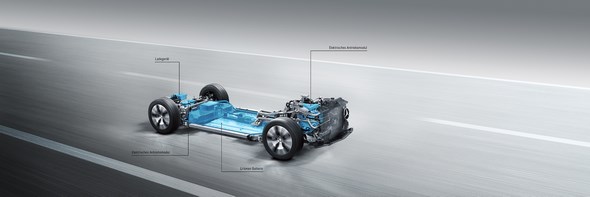
And every wish will be catered to with regard to colours and optional equipment – electric driving at smart offers maximum scope for customisation.

The charging time is an important factor for electric vehicle customers and the new smart electric drive also boasts major improvements here.
The smart is equipped with a battery from the Daimler subsidiary Deutsche ACCUMOTIVE. The company based in Kamenz, Saxony, has been building the electric heart of the smart electric drive since 2012.
Entering the new field of business with stationary battery storage also opens up interesting synergies for smart electric drive vehicles.
For example, the innovative replacement part and second use storage concept offers great potential for sustainable mobility (see section on “stationary energy storage”).
The smart fortwo coupé electric drive, the smart fortwo cabrio electric drive and the smart forfour electric drive are powered by the same electric motor.
The drive is produced in Renault’s plant in Clèon, Northern France.
After the world premiere in Paris, the new smart fortwo electric drive will be launched in the USA before the end of the year, where most recently around 25 percent of all smarts sold had battery-electric drive.
This will be followed by market launch of the two-seater and four-seater in Europe in early 2017.
Electric history at smart
With the start of the first electrically driven test fleet in 2007 in London, smart also took on a pioneering role in the field of electric mobility when 100 smart fortwo electric drives took to the roads of the British capital – with great success.
As early as 2009 smart launched the second generation of the smart fortwo electric drive; the model was introduced in 18 markets.
The objective was to gather as much experience as possible about how customers use and charge electric vehicles.
The huge demand exceeded all expectations. Instead of the planned 1000 vehicles more than 2000 smart fortwo electric drives were produced in Hambach.
From June 2012 the third generation smart fortwo electric drive also succeeded in winning wide-ranging buyers for its innovative and forward-looking drive concept.
Moreover, in 2013 the smart fortwo was the first all-electric vehicle from a European importer in China. In Germany, the electric smart established itself as the market leader among battery-electric vehicles within a very short space of time with a market share of around 40 percent and was able to maintain this position for three years in a row.
The smart electric drive also contributed to the success of the brand as part of the car2go fleet with 1,400 cars in three cities.
As car2go vehicles alone, the smart ed has covered more than 35 million km in demanding everyday usage since the launch.
Under the microscope: Mercedes-Benz GLC F-CELL
The fuel cell gets a plug
Fuel-cell technology is an integral part of Daimler’s drive system strategy. Because the advantages are clear: a long operating range and short refuelling stops as well as a broad spectrum of possible uses ranging from passenger cars to urban buses.
A new vehicle generation based on the Mercedes-Benz GLC is being launched in 2017. The Mercedes-Benz engineers joined forces with partners in the Daimler competence network to develop a new, compact fuel-cell system which for the first time fits into conventional engine compartments.
The GLC F-CELL features a large lithium-ion battery as a further innovation of the next-generation fuel-cell vehicles.
Rated at around 9 kWh, the battery serves as an additional energy source for the electric motor and can be charged externally by means of plug-in technology for the first time.
Together with the further developed intelligent operating strategy, the combination of fuel cell and battery system offers maximum efficiency and comfort.
With this set-up, the GLC F-CELL achieves a combined range of around 500 km in the NEDC.
Daimler relies on electric mobility with fuel cell. Vehicles such as the B-Class F-CELL and the Citaro FuelCELL-Hybrid urban bus have together now clocked up in excess of twelve million kilometres, clearly demonstrating that the drive concept is ready for market.
The next technology advance is now imminent: working together with partners from its global competence network, Daimler AG has developed an all-new fuel-cell system. Around 30 percent more compact than previously, it can be fully housed in the engine compartment for the first time.
The fuel cell developers have also further optimised the performance and operating range. Furthermore, the cost of the innovative technology has been slashed thanks largely to a 90-percent reduction in the amount of platinum used in the stack. From 2017, Daimler will be unveiling the new-generation fuel-cell technology based on the Mercedes-Benz GLC.
World first: plug-in fuel-cell drive goes into production
A lithium-ion battery for autonomous operation is being used in an electric vehicle with fuel cell for the first time. The powerful battery has a capacity of around 9 kWh and is housed at the rear of the SUV to save space.
It allows the GLC F-CELL to run on purely battery-electric power for up to 50 km in the NEDC and can be conveniently charged at a standard household socket, a Mercedes-Benz wall box or a public charging station.
Two carbon-fibre-encased tanks built into the vehicle floor hold around 4 kg of hydrogen. Thanks to the globally standardised 700-bar tank technology, the tank in the GLC F-CELL can be refilled at a hydrogen filling station within just three minutes, which is about the same amount of time it takes to refuel a car with an internal combustion engine.
The combination of fuel cell and plug-in battery is ideal given the progressive development of the hydrogen filling station infrastructure.
The innovative plug-in fuel-cell drive combines the advantages of both zero-emission drive technologies and, thanks to its intelligent operating strategy, continuously optimises the use of both energy sources in line with the current operating situation.
The system also features a recuperation function, for example, which allows energy to be recuperated and stored in the battery during braking and coasting phases. In total, the GLC F-CELL achieves a combined range of around 500 km in the NEDC.
Global competence network: access to key technologies
Part of the Daimler AG strategy involves ensuring direct access to key electromobility components. During development and production of the innovative fuel-cell drive, Daimler AG is able to call upon its global competence network.
The centrepiece of the technology, the fuel-cell stack, was developed in Vancouver, Canada together with partner Ford in the Automotive Fuel Cell Cooperation (AFCC) joint venture. The stack is produced in the neighbourhood at Mercedes-Benz Fuel Cell (MBFC).
Overall responsibility for the complete fuel-cell-drive assembly and the hydrogen storage system is developed from the Daimler subsidiary NuCellSys in Kirchheim/Nabern, Baden-Württemberg.
The Daimler strain plant Untertürkheim is responsible for an establishment for the fuel cell system installation, also at the location Nabern.
The hydrogen tank system consisting of carbon-fibre-encased tanks is produced at the Daimler Mannheim plant while the lithium-ion battery comes from Daimler subsidiary Deutsche ACCUMOTIVE located in Kamenz, Saxony.
Daimler is currently working systematically to prepare for series production of the Mercedes-Benz GLC F-CELL. The family-friendly SUV suitable for daily use is produced at the Mercedes-Benz Bremen plant, which acts as the competence centre for the model series.
The GLC has been rolling off the production line there since July 2015. Regarding to the drive system integration of the GLC F-CELL, the partner EDAG supports the factory Bremen and will settle in the immediate work area.
Under the microscope: battery technology
Further technological leaps expected
The idea of battery-electric driving is almost as old as the automobile itself. The development of battery technology has moved from large, heavy and weak lead/acid batteries to compact, lightweight and powerful nickel/metal hydride (NiMH) accumulators.
But it was only the introduction of lithium-ion technology in 2009 that brought the breakthrough in energy storage technology which makes electromobility a reality.
In the same year, with the S 400 HYBRID, Mercedes-Benz was the first manufacturer worldwide to bring a vehicle with this technology to market.
Nowadays all Mercedes-Benz plug-in hybrids and electric vehicles are based on it. Further technological leaps where batteries are concerned are expected in the coming decade through the launch of post-lithium-ion systems, with lithium-sulphur batteries currently the most promising.
Lithium-ion technology is currently the most efficient battery technology available, and also shows plenty of potential for the future.
No other battery technology meets the required parameters such as quality, output, service life and costs in the same measure.
New technologies, and especially those aimed at material-related improvements, plus ever-increasing production volumes leading to further price decreases, will determine the evolutionary development stages of the next few years.
Researchers and developers all over the world are already working on the next generation of battery technology.
The launch of what are known as post-lithium-ion systems can be expected within the next decade. Lithium-sulphur systems in particular promise a major technological leap forward, which is set to revolutionise the purchasing criteria that are highly relevant when it comes to buying electric vehicles: costs and range.
With the launch of the technology Daimler is expecting the energy density to double and the costs to halve, with the installation space remaining the same.
But the intelligence of the battery is not merely in the cell, but in the entire system. This is comprised of control electronics, software, cooling, the housing tailor-made for the vehicle and the cells.
A distinction must be made between round cells, prismatic cells and pouch cells. Which format is used will depend on the respective application in the vehicle because each of the cell housing variants has its own strengths and weaknesses.
Daimler has outstanding expertise in all three formats, and chooses the optimum cell type for its electrified vehicles from case to case.
Daimler AG already recognised at a very early stage that the availability of highly complex battery systems will continue to play an enormously important role for the automobile industry in the future.
With its subsidiary company Deutsche ACCUMOTIVE founded in 2009, the company is now the only German manufacturer with its own battery production, and it is currently expanding the capacities on a broad basis (for details see the two chapters “Expertise network” and “Stationary energy storage facilities”).
Under the microscope: expertise network
Bundling Expertise and Securing Know-How
In addition to its internal development and production expertise and its modular strategy for alternative drive systems, part of Daimler AG’s philosophy is to ensure that it has direct access to key components for electromobility.
Through its wholly owned subsidiary Deutsche ACCUMOTIVE, Daimler has extensive know-how when it comes to the development and production of highly complex drive batteries.
NuCellSys is a global leader in the development of fuel cell systems and hydrogen storage systems for vehicle applications.
The expertise network also includes joint ventures, for example with Bosch for electric motors (EM-motive) and with Ford for the development for fuel cell stacks (AFCC), but also as a partner with H2 Mobility GmbH in order to build up the hydrogen infrastructure.
On track for growth: Daimler is currently investing 500 million euros in the construction of a second battery plant in Germany, significantly increasing the capacities of Deutsche ACCUMOTIVE GmbH & Co. KG for the production of lithium ion batteries. ACCUMOTIVE, which was founded in 2009, is a wholly owned subsidiary of Daimler AG with facilities in Kirchheim/Nabern (R&D) and Kamenz (production). The company develops and markets highly complex drive batteries for hybrid and electric vehicles based on lithium-ion technology that are used in models of the Mercedes-Benz and smart brands. Since production started in 2012, more than 75,000 lithium-ion batteries have been delivered. The Daimler subsidiary has more than 420 employees, including 330 in Kamenz. From 2017, all of the battery systems for Mercedes-Benz and smart will be provided by Deutsche ACCUMOTIVE.
Daimler got involved in the new line of business with stationary battery storage in 2015, and has opened up additional opportunities to grow outside the automotive sector. Its subsidiary “Mercedes-Benz Energy GmbH“, which was only founded recently, is taking over the development and global distribution of stationary energy storage for the Mercedes-Benz brand with immediate effect. Please refer to chapter “Stationary energy storage facilities“.
Embase, a joint venture between Daimler AG, The Mobility House AG and GETEC, is set to commence operation of the world’s largest 2nd use battery storage facility this year in Lünen in the Westphalia region of Germany. Used systems from second-generation smart electric drive vehicles are combined to create a stationary storage facility and marketed on the German primary regulation energy market.
EM-motive is a joint venture between Daimler AG and Robert Bosch GmbH aimed at developing and producing electric motors. EM-motive GmbH’s registered offices and production facilities are in Hildesheim, while its development function is based in Ludwigsburg near Stuttgart. The motors have been used in various electric and hybrid vehicles since 2012, and EM-motive currently supplies the 80 kW electric motor for the new Mercedes-Benz E 350 e, for example.
NuCellSys GmbH is based in Kirchheim/Nabern in the Stuttgart metropolitan area. The wholly owned subsidiary of Daimler AG is a global leader in the development of fuel cell and hydrogen storage systems for vehicle applications. The company is responsible for system development and design, component and software development, and system validation. The fuel cell systems for existing cars (A- and B-Class) and buses were built in a small series production at NuCellSys GmbH. In addition, the operation of the current Mercedes-Benz B-Class F-CELL fleet and the care of H2 infrastructure projects are in the response of NuCellSys.
By founding the multi-sectoral joint venture H2 MOBILITY Deutschland GmbH & Co.KG in 2015, the six industrial companies Air Liquide, Daimler, Linde, OMV, Shell and Total paved the way for the gradual expansion of the Germany-wide network of hydrogen (H2) filling stations to up to 400 stations by the year 2023.
Daimler AG holds a majority share of 50.1 percent in “Automotive Fuel Cell Cooperation” (AFCC) in Burnaby to the East of Vancouver in Canada. The technological leader for research and development of fuel cell stacks for automotive applications was founded in 2008. The remaining share of 49.9% is held by the Ford Motor Company.
The stacks are also produced in the immediate vicinity of AFCC at Mercedes-Benz Fuel Cell (MBFC), which operates the world’s first plant dedicated entirely to the production and assembly of fuel cell stacks in British Columbia. MBFC started production back in June 2012.
Road #4: e-Mobility services
The mobility of the future will be more flexible and networked
Daimler has for years been developing from an automobile manufacturer into a mobility provider. The focus is no longer solely on the car as a product, but also on services related to mobility. Electric- and plug-in-vehicles, for example, include a Mercedes-Benz Wallbox installation service, and also exclusive Mercedes me connect functions. Another aspect of the corporate strategy is to offer new, innovative services for flexible and networked mobility. moovel provides the fastest connection between two places, taking all means of transport into consideration. With more than 1.3 million customers, car2go is the world’s leading carsharing company, and mytaxi is now used in 40 European cities.
The Mercedes-Benz Wallbox offers a private charging station for the home or business premises, even installed if the customer so wishes. The Wallbox in a Mercedes-Benz design impresses with an AC charging capacity of up to 22 kW (depending on vehicle), and can be installed inside or outside. Different variants of the Mercedes-Benz Wallbox are available from Mercedes-Benz dealers, and can be purchased there.
Mercedes me: Exclusive functions for electric vehicles
Mercedes me provides digital access to the world of Mercedes-Benz. Customers can use the portal to access services, products and lifestyle offerings from Mercedes-Benz, Daimler and cooperation partners.
Once registered, Mercedes-Benz drivers have access to personalised content – as well as to their own vehicle.
With the exclusive Mercedes me connect and the Remote Online functions available as standard, customers can conveniently view the state of charge, available range and nearest charging station on their smartphone.
Other Mercedes me connect services, which are available for all Mercedes-Benz vehicles include Mercedes-Benz Emergency Call*, Accident Recovery*, Breakdown Management*, Maintenance Management*, Telediagnostics*, Live Traffic Information*, Mercedes-Benz Apps*, Tracking services*, Remote Door Locking and Unlocking*, Remote Retrieval of Vehicle Status*, Programming of Auxiliary Heating*, Sending Navigation Destinations directly to the Vehicle*, Concierge service*, Car-to-X Communication* and Online Map Update* (*depending on the level of equipment).
moovel – Search mobility, book and pay with just one app
Multi-mode mobility platforms like moovel help to make urban transport simpler and more sustainable.
This intuitively operated smartphone app allows customers to compare different mobility services and find the best possible way from A to B.
The free smartphone app for Android and IOS consolidate what is on offer from different mobility service providers.
The result is a transparent and intelligent mobility network. In the process, moovel links urban public transport with individual transport and compares the connections in terms of time taken and cost.
Throughout Germany, car2go and Flinkster, mytaxi and tickets from the German railways can be easily and directly booked and paid for using the moovel app.
Since April 2016, tickets from the Hamburger local transport system can be bought directly on the moovel App. For the Stuttgarter local transport system this is already possible since November 2015.
moovel transit: Leading mobile ticketing solutions for transport operators in the USA
On 14 April 2016 the two US companies RideScout (Austin) and GlobeSherpa (Portland) were merged and renamed moovel North America (N.A.).
In the USA, moovel Group GmbH bases its operations on the two products moovel transit and RideTap. The mobile ticketing application from moovel transit is used by the principal transport operators in many US cities, and enables their customers to book and pay for urban public transport tickets using a smartphone.
In April 2016 alone, over 1 million urban public transport tickets were sold using the moovel transit mobile ticketing technology.
In 2016 the mobile ticketing application from moovel transit is to be introduced in further North American cities.
car2go: time rental of a smart in 30 cities worldwide
With the flexible mobility package car2go, customers are able to rent a smart at short notice at any time, and after use simply park it anywhere within the relevant business area.
1400 purely electrically powered smart fortwo cars are in operation in three locations.
The customer finds the vehicle using a smartphone, and only pays for the rental time which is exact to the minute.
Parking fees, fuel costs, taxes and insurance are already included. This is not only good for the wallet, but also for the environment – after all, the smart fortwo is a particularly eco-friendly car.
In selected cities car2go also uses electric vehicles. In this way the pioneer in flexible mobility concepts provides an opportunity to try out electromobility for oneself.
The worldwide carsharing market leader currently has more than 1.3 million customers, and is available in 30 cities and ten countries in Europe, North America and China.
charge@work: employees driving electric cars
The “charge@work” project, which was launched back in October 2013, offers employees the use of electric vehicles for both business and private use, and has been developed alongside the company’s charging infrastructure.
Since its launch, they have been able to hire a smart fortwo electric drive from the car pools at the company’s Möhringen, Untertürkheim and Sindelfingen sites.
The offer has been enthusiastically received and taken up by employees:
Now Daimler is upscaling electromobility to management level: in future the company’s management personnel will drive electrified company cars.
The arrangement applies to the company’s senior levels of management, and focuses primarily on plug-in hybrids. In a pilot project in the greater Stuttgart area, managers at various levels have already been driving the B 250 e since April 2015.
Did you know that…
…Mercedes-Benz not only offers electric cars, but also electric power? Mercedes-Benz is offering a green energy tariff in cooperation with EnBW Energie Baden-Württemberg AG (EnBW). It provides customers with electricity from 100% hydropower – clean energy from Mercedes-Benz.
… the app “Charge&Pay für Mercedes-Benz” simplifies charging and payment at public charging stations? For the whole of Germany, the app shows the nearest unused charging point at a charging station – whoever the power provider. The logbook function enables all charging processes, charging times and debits to be recorded. And after charging, cashless payment can be conveniently made by PayPal using a smartphone.
…B-Class Electric Drive drivers can borrow another Mercedes-Benz vehicle free of charge, e.g. when holidaying by car? The “B flexible Package” includes comprehensive credits for the free use of Mercedes-Benz Rent vehicles as well as free minutes for the car2go car sharing provider.The “B flexible Package” is an exclusive addition to every privately concluded leasing or financing agreement for a new B 250 e.
…in the greater Stuttgart area alone, Mercedes-Benz has already put 556 charging stations in place for the electric cars of its managers and employees? All in all, the company is making a short-term investment of 30 million euros in expanding the charging facilities in many of the company’s locations.
…Mercedes-Benz issues a battery certificate for its plug-in hybrids, guaranteeing a minimum operating life of six years or 100,000 kilometres for the high-voltage batteries? In the S-Class, the guarantee also applies to the plug-in components, e.g. the electric motor or power electronics. For the electric B-Class, Mercedes-Benz guarantees that if the contractual terms are complied with, the maximum energy content is no less than 19.6 kWh. This guarantee is valid for a period of eight years or up to a mileage of 100,000 km – whichever occurs first.
Under the microscope: stationary energy storage facilities
From car to grid: Daimler is gradually expanding in the field of stationary energy storage facilities
It’s not just on the road that Daimler is helping to bring about an energy turnaround: with its subsidiaries Deutsche ACCUMOTIVE GmbH und Co.
KG and Mercedes-Benz Energy GmbH, the company offers efficient battery systems for electric and plug-in vehicles as well as stationary energy storage facilities for industrial applications and households.
Daimler is systematically advancing electromobility in a series of innovative projects: as an example, used batteries from electric cars are getting a second lease of life outside of the vehicle as “2nd-use” battery storage devices.
In addition to this, a “living spare-parts store” for battery systems destined for the current smart electric drive fleet is helping to stabilise the German power grid.
This efficient dual use improves the LCA and the life cycle costs of electromobility.
By becoming involved in the field of stationary energy storage facilities for industrial customers and household applications through its wholly owned subsidiaries Deutsche ACCUMOTIVE GmbH und Co.
KG and the recently formed Mercedes-Benz Energy GmbH, Daimler AG is tapping into new growth opportunities and actively helping to bring about an energy turnaround in the non-automotive sector, too.
Deutsche ACCUMOTIVE develops, produces and markets highly complex drive batteries for Mercedes-Benz and smart hybrid and electric vehicles based on lithium-ion technology.
Its extensive battery know-how in the automotive sector is now benefiting stationary battery storage facilities as products that have proven themselves over millions of kilometres under the toughest conditions such as heat and cold are also ideal for stationary use.
Within the innovative business model, the recently formed Mercedes-Benz Energy GmbH is now assuming responsibility for development and global marketing of Mercedes-Benz stationary energy storage facilities.
This move gives Daimler’s activities in the growing market for stationary batteries an even sharper focus. For the stationary storage facility business, this independence means an increase in flexibility.
When its comes to approaching customers in particular, there are clear advantages as the customer group for Mercedes-Benz energy storage facilities is far more diversified than the customer group in the automotive sector, ranging from households to large-scale industry.
The first lithium-ion storage facility on an industrial scale is already on the grid and is operated by partner companies The Mobility House AG and GETEC Energie AG.
There are numerous possibilities for stationary energy storage facilities as the concept goes way beyond large-scale industrial applications.
The business model, developed in collaboration with Daimler Business Innovation, the Daimler think tank for new business ideas, also includes operations in medium-sized businesses such as supermarkets.
Here, too, the stationary energy storage facilities can assist at times of peak demand, such as on hot days.
Mercedes-Benz energy storage facilities are also suitable for private use. Daimler AG started supplying these Home energy storage facilities at the end of April 2016.
Up to eight battery modules with an energy content of 2.5 kWh each can be combined to produce an energy storage unit with a capacity of up to 20 kWh. Households with their own photovoltaic systems can therefore buffer surplus solar power with virtually no losses.
By combining renewable energy sources with a local battery storage unit, private households can increase their self-consumption of generated energy to as much as 65 percent, thereby bringing about their own “private energy revolution”.
Reuse of discarded batteries from electric cars
The life cycle of a plug-in or electric vehicle battery does not have to end after its has done its duty in the vehicle as it can be reused for stationary energy storage units.
That’s because stationary applications are not susceptible to minor power losses, meaning that economical stationary operation is possible for at least ten more years, it is estimated.
Reusing the lithium-ion modules in this way almost doubles their economical usage.
The world’s largest 2nd-use battery storage facility is currently under construction in Lünen, Westphalia. In Lünen, battery systems from the second generation of smart electric drive vehicles are being incorporated into a stationary storage unit with a total capacity of 13 MWh.
A joint venture between partners Daimler AG, The Mobility House AG and GETEC will be taking the stationary storage facility into operation before the end of this year at the REMONDIS SE site and marketing it on the German primary balancing energy market.
Spare-parts store as energy storage unit
Even battery systems that have not yet been used in electric cars and are instead stored as spare parts can double up as energy storage units.
Cooperation partners Deutsche ACCUMOTIVE and enercity (Stadtwerke Hannover AG) will start construction work on a new battery storage facility this year.
What makes it particularly special is the fact that this is a spare parts storage facility for electromotive battery systems. Around 3000 of the battery modules set aside for the current smart electric drive vehicle fleet are being pooled to create a stationary storage facility at the enercity site in Herrenhausen.
With a storage capacity totalling 15 MWh, the installation is one of the largest of its kind in Europe. After completion, the energy storage facility will be marketed on the German primary balancing energy market (PRL).
In this way, the business model makes an important contribution to stabilisation of the power grid and to the economic efficiency of electromobility.
In the event of increasing fluctuations in electricity feed-in from renewable energies such as wind and solar energy, such storage units help to ensure optimum setting of a mains frequency that has to be kept constant.
Mercedes-Benz Vans
Proven all-electric drive: the Vito E-CELL
The Mercedes-Benz Vans portfolio includes strong partners of all sizes, geared to providing efficient transport: the Citan urban delivery van, the Vito mid-size van, the V-Class MPV or perhaps the large-size Sprinter van.
Proof that the transport of both people and goods can be achieved without any emissions whatsoever has been provided since 2010 by the electric-powered Vito E-CELL.
Since then some 900 examples of this van, configured for a payload of 900 kg, have gone into operation with customers.
At the end of the four-year leasing period the electric Vito models are still in such good condition that customers are being given the opportunity to extend their contract by a further two years.
This two-year offer is also being made to new customers. Demand well exceeds supply. The Vito E-CELL is also being offered through CharterWay on a short-term rental basis.
Volker Mornhinweg, Head of Mercedes-Benz Vans: “Personally, I am firmly of the belief that the future of delivery services in our cities will be largely ‘electric’. Which is why we continue to press forward with our work in this field.”
Accommodated under the bonnet of the Vito are the electric motor, power electronics, transformer and an AC/DC charger.
The electric motor delivers an output of 60 kW in conjunction with maximum torque of 280 Nm. The powerful and durable lithium-ion traction batteries located underneath the load-compartment floor have a capacity of 36 kWh and allow a real-life range of at least 80 km.
Eco-friendly and economical: the Sprinter 316 NGT
A particularly economical and eco-friendly option is available in the form of the Sprinter with Natural Gas Drive.
This can take on board a pressurised gas tank with a capacity of 125 litres or a liquid gas tank holding 210 litres.
The van is available as a 316 NGT in monovalent or bivalent variants. In the monovalent variant, premium grade petrol is used purely for starting purposes or as a reserve – the tank holds 15 litres.
The bivalent variant has a petrol tank with a capacity of 100 litres and thus a phenomenal range. The engine is a 1.8-liter four-cylinder unit with an output of 115 kW/156 hp and 240 Nm of torque.
Mercedes-Benz Commercial Vehicles
Through the city on electric power
As one of the world’s leading manufacturers of trucks and buses, Daimler has always set a strong example when it comes to ecofriendly innovations.
With commercial vehicles it’s always about ensuring a perfect match between two things: economy and ecology.
This results in the development of a wealth of technologies that must prove themselves on a daily basis: from the battery-electric-powered Fuso Canter E-Cell light-duty truck to gas-driven buses, a range of hybrid vehicles and the Actros heavy-duty truck with a highly efficient diesel engine.
The electrically powered Fuso Canter E-Cell light-duty truck has been in commercial fleet testing since 2015. Initially in Portugal, its country of production, a total of five of these vehicles have now also been on the road for Stuttgart city council and the logistics company Hermes since April of this year.
In place of a diesel engine, an electric powertrain with a powerful permanent-magnet motor delivers 110 kW (150 hp) of power to the rear axle via a single-speed transmission.
Available from the very first second of operation, a torque of 650 Nm gives the six-tonne truck almost the same acceleration as a passenger car.
As with all vehicles in this weight category, the top speed of the Canter E-Cell is limited to 90 km/h. The batteries weighing around 600 kg allow ranges of over 100 kilometres, thus exceeding the daily distance covered by many light-duty trucks used for short-radius distribution.
Citaro NGT world premiere: climate-neutral transport with bio natural gas
Daimler Buses unveiled the new natural-gas-driven Mercedes-Benz Citaro NGT urban bus in 2015. Featuring the newly developed M 936 G gas engine, it has become a benchmark for natural-gas buses.
The Citaro NGT is 20 percent more efficient than its predecessor. Furthermore, it is practically CO2-neutral if bio natural gas is used.
It easily meets the extremely strict Euro VI emissions requirements in many cases. And it does this without the need for the diesel engine’s familiar SCR technology with AdBlue injection or a particulate filter thanks to practically particulate-free combustion.
Western Europe’s urban-bus market amounts to around 10,500 new registrations a year on average and remains steady at this level.
The highly specialised European segment for urban buses with natural-gas engines currently accounts for just under 1000 units a year.
Daimler Buses expects this number to keep rising in future because of environmental projects in urban areas.
As an alternative to the further optimised drive system with internal combustion engine, the next stops en route to the future are the Citaro E-CELL and Citaro F-CELL.
Both are based on a shared E-Mobility platform. On this basis, Daimler Buses is expecting the production version of the battery-electric-powered Citaro E-CELL to start hitting the road in 2018. In this development work, Daimler Buses benefits from its integral position within the Group as all the vehicle divisions are working closely together on the road to locally emission-free driving.
Bundling of research work is therefore possible here. Certain components such as the fuel cell stacks can also be used in cars and commercial vehicles alike.
Fuso Canter Eco Hybrid: no 7.5-tonne vehicle is more frugal or has a higher load rating
The Fuso Canter with hybrid drive has been in production in Portugal since October 2012. Its fuel consumption is up to 23 percent lower than that of the conventional Canter model.
From this comes the highly sophisticated four-cylinder turbo diesel with a displacement of 3.0 l, an output of 110 kW (150 hp) and a maximum torque of 370 Nm.
The BlueTec 6 engine meets the requirements of the Euro VI emissions standard. Its emission control system combines exhaust gas recirculation, SCR engine technology with AdBlue injection and a particulate filter.
The electric motor, with an output of 40 kW and a maximum torque of 200 Nm, obtains its energy from lithium-ion batteries.
They provide a capacity of 2 Ah and weigh just 63.5 kg. The additional weight resulting from the hybrid drive amounts to only around 150 kg.
This means a load capacity of up to 4.8 t for the 7.5-tonne model as a chassis with cab.
Mercedes-Benz Actros: economy and ecology in perfect harmony
Never before has a long-haul truck been as systematically designed for maximum efficiency as the Mercedes-Benz Actros. It stands for the ultimate in economy in the tough transport business.
With the introduction of the latest-generation OM 471 heavy-duty engine, the already low fuel consumption is further reduced by up to three percent.
This is not only good for the company’s bank balance, it also preserves resources: assuming an annual mileage of 130,000 km in long-haul transport and a consumption of approx. 28.5 litres/100 km on a demanding route covered at full load capacity, every single Mercedes-Benz Actros with the latest-generation OM 471 engine would save around 1,100 litres of fuel a year.
This is equivalent to a reduction in CO2 emissions of around three tonnes for every single truck. Businesses benefit first and foremost from the low costs: low fuel and oil consumption, extremely long maintenance intervals of up to 150,000 km, as well as the engines’ robust and durable qualities.
This is largely thanks to the state-of-the-art technology in the six-cylinder in-line engine with a displacement of 12.8 l, an output of 390 kW (530 hp) and a torque of up to 2,600 Nm: two overhead composite camshafts, the unique common-rail injection system with X-Pulse pressure booster, the asymmetric exhaust gas turbocharger, the powerful engine brake and emission control with SCR technology, exhaust gas recirculation and particulate filter to meet the requirements of the strict Euro VI emissions standard.
History
Sights always set on alternatives
How long will the oil reserves last? Are there better powertrains than the internal combustion engine?
These issues are being discussed since the car was invented, at constantly changing intensity.
The discussion is determined by economic, political and technical factors. The search for alternative powertrains was thus already an issue during the era of Benz & Cie. and Daimler-Motoren-Gesellschaft. It is also a constant presence for Mercedes-Benz vehicles.
Electric cars (since 1899)
Motorfahrzeug- und Motorenfabrik Berlin AG Company, the precursor of the Mercedes-Benz Berlin plant, presented its first electric vehicle as early as in 1898.
Project partner of the “motor vehicle and engine factory” in Berlin-Marienfelde was American Columbia Electric Company based in Connecticut.
The motor, whose battery was housed in the body of the car, sent its power to the rear axle via a gear drive.
The “electric semi-coach” model weighed 1,800 kilograms, had a range of 40 kilometres, consumed 0.34 kilowatt hours per kilometre, managed inclines of up to seven percent, and cost 9300 marks.
The first electrically powered Mercedes was built in 1907. A contemporary report about the motor show in Vienna in spring 1907 had this to say: “The elegance of the electric urban vehicle is perfectly illustrated by several Mercedes-Electriques, which were very well received at the exhibition.”
Mercedes-Electrique vehicles were used in particular as fire engines and buses. The advantages they offered were that they were always ready to start promptly, and were relatively cheap to run.
This was because mechanical components such as transmission, clutch or chains were no longer needed to transfer the power, thanks to electric wheel hub motors.
In 1908, the Berlin fire brigade, for example, also opted for electric vehicles when a new fire company comprising four Mercedes-Electrique vehicles was put into service (gas pumper truck, steam pumper truck, water tender and turntable ladder truck).
The first concept for a modern electrically powered van at Mercedes-Benz was created in 1972 – the LE 306. The engine developed 31 kW (42 hp), achieved a maximum speed of 70 km/h, and had a range of 65 kilometres.
The LE 306 was also used at the 1972 Olympic Games in Munich. In the years that followed, a total of 89 electric vans collectively clocked up some 2.9 million kilometres in test drives.
In early 1982, Mercedes-Benz began testing the electric powertrain for passenger cars. The research car based on a 123-series estate model had a novel powertrain concept.
A single module comprised a DC drive motor (continuous output 25 kW/34 hp, peak output 32 kW/44 hp), a multi-disc start-off clutch, an automatic transmission (derived from a passenger car automatic transmission), an upstream two-cylinder internal combustion engine (10 kW/14 hp) with noise encapsulation for emergency power, and an in-line centrifugal clutch.
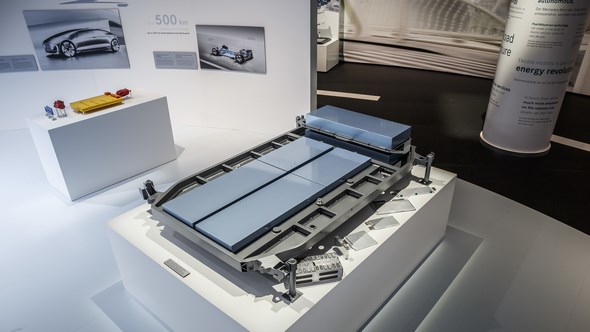
The modified load compartment housed a newly designed nickel-iron battery. The vehicle had a range of about 100 kilometres.
A Mercedes-Benz 190 (201 series) was the basis for another electric test car that was presented to the public in 1991.
Two electric motors excited by permanent magnets, each with a peak output of 16 kW (22 hp), drove the rear axle directly.
Due to the high torque across the entire rev range, no transmission was needed. This meant that the drivetrain and the losses it entails could be eliminated.
The compact and lightweight design created space and saved on weight. However, this solution was more expensive than a conventional DC motor.
Under the bonnet of this “laboratory on wheels” was a lot of electronic equipment for controlling the powertrain, and a battery. A second battery and measuring instruments took up almost the entire boot.
In 1992, a four-year demonstration project started on the island of Rügen to test the latest generation of electric vehicles and gain information about their performance under real-life conditions.
All in all, 60 passenger cars and vans from various manufacturers participated in the project. Mercedes-Benz supplied ten further advanced 190 models and ten likewise improved MB 100 vans with different kinds of combinations of electric motor and battery.
The vehicles were charged at standard power outlets and also at special charging stations, whose electricity was generated in part directly from sunlight.
At the 1992 Olympic Games in Barcelona, the MB 100 E was used as a support and transport vehicle. It was fitted with a DC shunt wound motor, producing 28 kW (38 hp) and enabling a top speed of 80 km/h with a maximum range of 80 kilometres.
Testing of electric powertrains continued. A prototype based on the C-Class (202 series) powered by an asynchronous electric motor (35 kW/48 hp) was built in 1993. Zebra high-energy batteries from AEG gave the concept car a range of 110 kilometres.
The engineers accommodated all the technology in the car so skilfully that the electrically powered Mercedes-Benz offered almost the same space as a standard C-Class Saloon.
The payload capacity was still as high as 370 kilograms. The safety level was identical to that of a production C-Class.
In 2006, a pilot project of the smart brand was launched in the UK.Electric smart cars started daily operations there in November that year.
The company provided approximately 100 vehicles for lease to selected British customers. The car was powered by an electric motor with an output of 30 kW (41 hp). It was the starting shot for the electric success story at smart – please see corresponding chapter.
In 2012, Mercedes-AMG started a new era with the SLS AMG Coupé Electric Drive: The locally emission-free super sports car featuring hi-tech from Formula 1 racing represented the most exclusive and dynamic form of electric motoring.
The most powerful AMG high-performance vehicle was equipped with four electric motors with a system output of 552 kW and a peak torque of 1000 Nm, making the Gullwing the world’s fastest electrically powered production vehicle: The SLS AMG Coupé Electric Drive accelerated from zero to 100 km/h in 3.9 seconds.
The first B-Class Electric Drive came off the assembly lines at the Mercedes-Benz Rastatt plant in November 2014.
This marked the first time that Mercedes-Benz models with internal combustion engine and electric powertrain were built on one and the same assembly line.
The B-Class Electric Drive is based on the front-wheel-drive architecture of the new Mercedes-Benz compact car generation and makes use of the modular component system. The batteries are housed safely in the underbody of the vehicle (ENERGY SPACE).
Hybrid powertrains (since 1907)
Hybrid powertrains, especially the combination of electric motor and internal combustion engine, are an important option for future motor vehicles.
Mercedes-Benz has been conducting research in this field continuously since 1969. However, the tradition of hybrid powertrains dates back even farther in the history of the brand: Daimler Motorengesellschaft Wiener Neustadt presented a Mercedes-Mixte developed by Ferdinand Porsche as early as in 1907.
Hybrid models of various passenger and commercial vehicles followed. Hybrid powertrains continued to be used until the first quarter of the 20th century.
In 1969, the OE 302 hybrid bus marked a new start for hybrid research. In the years that followed, (for the first time in a passenger vehicle in the electric estate model of the 123 series, see above), more than 20 concept and research vehicles with hybrid powertrains were built in all vehicle categories from the smart HyPer sub-compact car to the Atego truck.
In 2005, Mercedes-Benz first presented an S-Class with hybrid powertrain at the North American International Auto Show in Detroit.
At the 2005 International Motor Show (IAA) in Frankfurt, two more concept vehicles based on the new V 221 S-Class were then on display: the DIRECT HYBRID with petrol engine and electric motor, and the BLUETEC HYBRID, which combined a diesel engine with an electric motor.
The electric motor of both concept vehicles produced 6 kW (8.2 hp). It was used a starter motor and a start-off booster, and was also able to function as a generator for converting kinetic energy into electricity.
With 20,000 buyers worldwide, the production S 400 HYBRID became a success from more than just a technical standpoint starting in 2009.
It consumed just 6.3 litres of fuel per 100 kilometres (combined) in the NEDC. This represented a reduction by 20 percent over the predecessor.
CO2 emissions of 147 grams per kilometre were also a record in this vehicle segment. These exemplary figures went hand in hand with outstanding performance: The petrol engine produced an output of 225 kW (306 hp), while the electric motor added another 20 kW (27 hp).
The internal combustion engine’s peak torque of 370 Nm was supplemented with another 250 Nm from the electric motor.
In 2013, Mercedes-Benz launched the S 300 BlueTEC HYBRID, which combined the 2.2-litre four-cylinder diesel engine rated at 150 kW (204 hp) with a powerful hybrid module developing 20 kW (27 hp).
The peak torque of 500 Nm produced by the internal combustion engine was boosted by 250 Nm of peak torque generated by the electric motor.
The S 300 BlueTEC HYBRID made do with 4.4 litres per 100 km in the combined cycle (CO2: 115 g/km), and complied with the criteria for energy efficiency class A+.
Consequently, Mercedes-Benz cut fuel consumption in the 150-kW performance class by nearly half over the course of ten years.
The S 500 PLUG-IN HYBRID was another milestone in 2014. It offered a system output of 325 kW with 650 Nm of torque, accelerated from 0 to 100 km/h in just 5.2 seconds and had an all-electric range of up to 33 km.
The certified consumption of 2.8 litres/100 km corresponded to 65 g CO2/km emissions. Key elements of this impressive performance were the twin-turbo V-6 and the intelligent hybrid powertrain.
Its new high-voltage lithium-ion battery with an energy content of 8.7 kWh could be externally recharged via a charging socket in the right side of the rear bumper.
At the same time, the S 500 PLUG-IN HYBRID marked the start of the hybrid initiative at Mercedes-Benz: By 2017, the company will launch a total of ten plug-in hybrid models, which translates into one new model with hi-tech hybrid powertrain every four months on average.
All milestones of the hybrid powertrain at a glance:
Research vehicles
- 1982: Mercedes-Benz concept with two-cylinder horizontally opposed engine
- 1993: Mercedes-Benz “Taxi Hybrid” as first parallel hybrid. A C-Class combined a 55 kW (75 hp) four-cylinder diesel engine with an electric motor producing 130 Nm and 20 kW (27 hp).
- 2001: smart fortwo cdi. A 20 kW (27 hp) electric motor in concert with the 30 kW (41 hp) three-cylinder diesel engine formed a highly space-saving unit.
- 2002: Mercedes-Benz Unimog “E-Drive”
- 2002: Mercedes-Benz M-Class “HyPer”. An ML 270 CDI with a 120-kW (163-hp) common-rail diesel engine and automated transmission. It featured an electric motor with an output of 45 kW (61 hp) and high torque, installed between the diesel engine and the transmission.
- 2003: Mercedes-Benz F 500 Mind. The four-litre V-8 diesel engine produced 178 kW (242 hp) of power and 560 Nm of torque. The electric motor added another 48 kW (65 hp) and 300 Nm. The company featured the same powertrain in the Mercedes-Benz Vision Grand Sports Tourer concept vehicle.
- 2004: Mercedes-Benz Sprinter with plug-in-hybrid powertrain
- 2005: Mercedes-Benz S-Class “Hybrid”. Eight-cylinder diesel engine producing 191 kW (260 hp) of power and 560 Nm of torque, plus two electric motors with a total output of 50 kW (68 hp).
- 2005: smart crosstown. Hybrid model with three-cylinder petrol engine (45 kW) and electric motor (23 kW)
- 2009: Concept BlueZERO in three versions: as an electric car (E-CELL), fuel-cell-powered vehicle (F-CELL) and with range extender (E-CELL PLUS)
Production cars (hybrid and electric drive)
- 2009: S 400 HYBRID (20,000 buyers worldwide)
- 2009: ML 450 HYBRID
- 2012: smart electric drive
- 2012: E 300 BlueTEC HYBRID
- 2012: E 400 HYBRID
- 2013: SLS AMG Coupé Electric Drive
- 2013: S 400 HYBRID
- 2013: S 300 BlueTEC HYBRID
- 2014: C 300 BlueTEC Hybrid
- 2014: B-Class Electric Drive
- 2014: S 500 PLUG-IN HYBRID
- 2015: C 300 e
- 2015: GLE 500 e
Fuel cell cars (since 1994)
The first fuel-cell-powered vehicle in the world, with which the Daimler-Benz researchers demonstrated the viability of the fuel cell for powering a vehicle in 1994, went by the name NECAR 1 (“New Electric Car”).
The experimental vehicle, a Mercedes-Benz van, resembled a laboratory on wheels: The load compartment was filled with 800 kilograms of still voluminous fuel cell system and small hydrogen tank.
NECAR 2, a Mercedes-Benz V-Class with integrated fuel-cell power unit under the short bonnet, hit the road as early as in 1996. The six seats were reserved for the occupants.
The hydrogen tanks were mounted on the roof. The vehicle reached a top speed of 110 km/h and had a range of around 250 kilometres.
NECAR 3, based on the Mercedes-Benz A-Class, started its test runs already in 1997. The vehicle was fuelled with methanol and for the first time the hydrogen was generated on board using a “reformer”.
The reformer spontaneously converted fuel into hydrogen when the accelerator pedal was depressed. It still took up a lot of space in the boot.
The other components of the system were housed in the sandwich floor of the vehicle. The tank capacity of 38 litres was enough for a range of around 400 kilometres.
NECAR 4 was a zero-emission vehicle (ZEV) for operating purely on hydrogen. The vehicle based on an A-Class offered room for five people plus luggage. The liquid hydrogen was carried in a cylindrical tank in the rear.
The vehicle had a range of up to 450 kilometres and reached a top speed of 145 km/h. Because NECAR 4 emitted absolutely no emissions, it already complied with the future statutory emission limits of the US State of California in 1999.
Number 4 represented a crucial step on the road to production readiness. A variant of NECAR 4, equipped with even more advanced technology and three tanks with compressed hydrogen in the rear, was also used for practical testing in California, where intensive field and road tests under real-life conditions were conducted with a total of 15 vehicles until 2003.
On NECAR 5, presented on 7 November 2000, the entire fuel cell system including the methanol reformer was for the first time housed in the sandwich floor of the Mercedes-Benz A-Class. This meant the entire interior belonged to the passengers and their luggage.
NECAR 5 was some 300 kilograms lighter than its direct predecessor NECAR 3 thanks to a number of weight-saving measures.
This also benefited the driving dynamics and the acceleration. The vehicle reached a top speed in excess of 150 km/h.
NEBUS, the “New Electric Bus” presented in 1997, represented the transfer of the fuel cell technology to the commercial vehicle sector by Mercedes-Benz.
The hydrogen was stored in seven glass-fibre-encased aluminium tanks on the roof. One full tank was enough for a range of 250 kilometres, sufficient for the daily workload of a bus in line service.
In 2003, the first 30 urban buses with fuel cell powertrain went into operation in large European cities, followed by more buses all around the world.
In 2005, Mercedes-Benz presented the F 600 HYGENIUS research vehicle at the 39th Tokyo Motor Show.
The new fuel cell was 40 percent smaller than previous systems, but also significantly more efficient and powerful: The system produced an output of 85 kW (115 hp) and developed a peak torque of 350 Newton metres.
The fuel cell powertrain finally went into (small-)series production in 2010. Produced under series production conditions, the Mercedes-Benz B-Class F-CELL has since been in day-to-day operations with customers on the European and American markets.
The total mileage of the Daimler fuel cell fleet, which now numbers more than 300 vehicles including a host of research vehicles, has presently reached the fourteen million kilometre mark.
By itself, the B-Class F-CELL fleet of about 200 vehicles has now covered a distance of around eight million kilometres.
In 2011, Mercedes-Benz presented the F 125! research vehicle as the highlight of the 125th anniversary of the motor car.
The concept of a four-seat luxury saloon combined cutting-edge, high-efficiency storage, powertrain and bodywork technologies with unique operating and display concepts.
At the heart of the powertrain was an especially powerful advancement of the fuel cell system from Mercedes-Benz in combination with the plug-in technology.
Other highlights were lighter and more efficient energy storage units based on lithium-sulphur technology and the so-called “structurally integrated hydrogen composite storage system”, which integrated the hydrogen tanks fully into the body structure.
Four powerful electric motors positioned near the wheels delivered sporty and superior driving performance.
The powertrain of the F 125! was further advanced in the F 015 Luxury in Motion (2015) research vehicle.
The fuel cell stack was further optimised in terms of performance, efficiency and durability, and delivered the traction current for two electric motors, each with an output of 100 kW (136 hp).
These are installed in a compact arrangement in the rear end of the vehicle and channel their power to the rear wheels.
The electrical powertrain generates a total peak output of 200 kW (272 hp). The electric hybrid system has a total range of 1100 kilometres, of which some 200 kilometres can be driven on the especially powerful and compact high-voltage battery, and around 900 kilometres on the electricity produced in the fuel cell. The design provides for the use of CFRP pressure tanks for hydrogen storage.

